|
In The News — Water Grab News — 2015
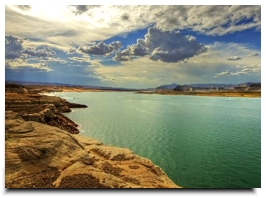 December 28, 2015 — Reservoir evaporation a big challenge for water managers in West — Water managers in Colorado and the West scrambling to meet the growing demand for increasingly scarce water supplies caused by large populations far from water resources, climate change and drought need to focus more effort on conserving water, including addressing reservoir evaporation, say University of Colorado Boulder researchers — University of Colorado Boulder
December 28, 2015 — Reservoir evaporation a big challenge for water managers in West — Water managers in Colorado and the West scrambling to meet the growing demand for increasingly scarce water supplies caused by large populations far from water resources, climate change and drought need to focus more effort on conserving water, including addressing reservoir evaporation, say University of Colorado Boulder researchers — University of Colorado Boulder
December 26, 2015 — New drought report could be road map for Nevada water policy — A panel of water experts that spent almost a year analyzing Nevada’s persistent drought has issued recommendations that could shape Gov. Brian Sandoval’s policy agenda in the coming year. The eight-member Nevada Drought Forum, which Sandoval commissioned in April, included water, agriculture, climate and emergency management officials who gathered information in a series of public meetings over the past year — AP [Print News Story ] [Read Executive Summary] [Read/Download the full report] 
December 2015 — Drought in the Colorado River Basin Insights using open data — Since 2000, the Colorado River Basin (Basin) has been experiencing a historic, extended drought that has impacted regional water supply and other resources, such as hydropower, recreation, and ecologic services. During this time, the Basin has experienced its lowest 16-year period of inflow in over 100 years of record keeping, and reservoir storage in the Colorado River system has declined from nearly full to about half of capacity. This application was developed by the U.S. Geological Survey and the Bureau of Reclamation in support of the Department of the Interior’s Open Water Data Initiative (OWDI). This visualization is part of a multi-agency effort to showcase the usefulness of open data (i.e., data provided in a discoverable, sharable, and machine-readable format) by exploring the current 16-year drought and its effects on the Colorado River Basin — U.S. Geological Survey and the Bureau of Reclamation
December 21, 2015— Subcommittee to study Nevada water laws — Las Vegas Sun
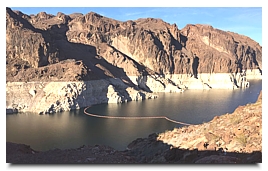 December 21, 2015 — Feds: Fix Colorado River problems or we will — For the second time in a decade, the feds are warning that if water interests in Arizona, California and Nevada cant find a fix for the Colorado River's problems, the interior secretary will find it for them. Deputy Interior Secretary Michael Connor implied that was the department's position in a talk Friday to hundreds of water officials, farmers and others gathered in Las Vegas for the 70th annual conference of the Colorado River Water Users Association. After his speech, Connor came right out and said it in response to a reporter's questions. Connor talked of the need to prevent Lake Mead, about 25 miles south of Las Vegas, from falling to dangerously low levels at potentially low enough to force Draconian cutbacks in water deliveries to cities and Indian tribes in Arizona, as well as to farms — Arizona Daily Star
[Mobil Link]
December 21, 2015 — Feds: Fix Colorado River problems or we will — For the second time in a decade, the feds are warning that if water interests in Arizona, California and Nevada cant find a fix for the Colorado River's problems, the interior secretary will find it for them. Deputy Interior Secretary Michael Connor implied that was the department's position in a talk Friday to hundreds of water officials, farmers and others gathered in Las Vegas for the 70th annual conference of the Colorado River Water Users Association. After his speech, Connor came right out and said it in response to a reporter's questions. Connor talked of the need to prevent Lake Mead, about 25 miles south of Las Vegas, from falling to dangerously low levels at potentially low enough to force Draconian cutbacks in water deliveries to cities and Indian tribes in Arizona, as well as to farms — Arizona Daily Star
[Mobil Link]
December 20, 2015 — UPDATE: Faraday incentives and Apex industrial site improvements — S. Bradhurst
December 19, 2015 — Proposed Faraday factory's water needs drag special session into weekend — news3LV
December 17, 2015 — Human water use 'greater than thought'
— BBC
December 18, 2015 — Water issue likely on tap Friday at special session — CARSON CITY — The Nevada Legislature was back in session today . . . The Senate first took up the large omnibus bill that includes the bulk of the components of the Faraday Future deal — tax abatements, transferable tax credits and some measures necessary for infrastructure improvements at Apex Industrial Park, soon to be home to electric car company Faraday Future’s manufacturing $1 billion manufacturing plant in North Las Vegas — Las Vegas Sun [Mobil Link]
December 17, 2015 — Faraday Future special session hits hang up — Senate Bill 1, the primary piece of legislation to make the Faraday Future deal happen, got hung up in the Senate Thursday night. Opponents say legislative language made critical changes to long-standing Nevada water law. Republican Sens. Pete Goicoechea, of Eureka, and James Settelmeyer, of Gardnerville, both argued that a two-day special session was not the place to make dramatic changes in water law that is supported by 150 years of legal case law . . . The total state benefit to the [Faraday] plant comes to $335 million. — Nevada Appeal
December 16, 2015 — Western water and climate change . . . The Colorado River is a system in which overuse and growing demands are projected to be even more challenging than climate-change-induced flow reductions — tenaya.ucsd.edu
December 15, 2015 — [Nevada Gov.] Sandoval calls two-day special session for Faraday Future incentives — CARSON CITY: Gov. Brian Sandoval late Tuesday issued a proclamation calling the Nevada Legislature into session beginning at 5 p.m. Wednesday to consider a package of tax incentives to bring the startup electric car manufacturer Faraday Future to Southern Nevada. Sandoval asked lawmakers to convene to consider a session to review a package of tax abatements and credits to bring Faraday Future to the Apex industrial site in North Las Vegas — Las Vegas Review Journal [Mobil Link]
  Readers Note: regarding water and infrastructure "incentives" see section 3, 4 & 5 of the Proclamation Readers Note: regarding water and infrastructure "incentives" see section 3, 4 & 5 of the Proclamation
December 13, 2015 — Please take a few minutes and watch this amazing speech from Dan Beard, former Commissioner of the Bureau of Reclamation, as he accepts the "Mark Dubois Award" from Friends of the River —  [Related Information] [Related Information]
December 14, 2015 —
Governor’s Budget Recommendations Undermine Lake Powell Pipeline — St George- Backers of the Lake Powell Pipeline (Pipeline) received a setback when Governor
Gary Herbert released his 2016 Budget Recommendations on water. His recommendations lend support from the state’s highest office to advocates for fiscal responsibility and water
conservation — Citizens For Dixie's Future
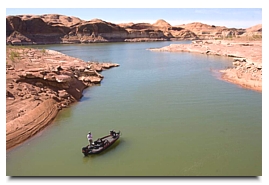 December 12, 2015 — Massive document provides clues to Utah’s Lake Powell Pipeline as guv, others question need — The recently released draft proposal for the Lake Powell Pipeline offers the most in-depth analysis of the project to date, but it may raise more questions than it answers. And that's what state officials say it is supposed to do, with the document — more than 1,300 pages long, not counting several hundred pages of supplementary material — now up for public review and comment — Salt Lake Tribune [Print PDF]
December 12, 2015 — Massive document provides clues to Utah’s Lake Powell Pipeline as guv, others question need — The recently released draft proposal for the Lake Powell Pipeline offers the most in-depth analysis of the project to date, but it may raise more questions than it answers. And that's what state officials say it is supposed to do, with the document — more than 1,300 pages long, not counting several hundred pages of supplementary material — now up for public review and comment — Salt Lake Tribune [Print PDF]
December 12, 2015 — Low Level Pumping Station Work Begins on Lake Mead — As a companion to Intake No. 3 on Lake Mead, the Southern Nevada Water Authority (SNWA) is building the low lake level pumping station, a project whose cost is estimated at $650 million, in the Lake Mead National Recreation Area, just 500 ft. (152.4 m) from the new intake — constructionequipmentguide.com
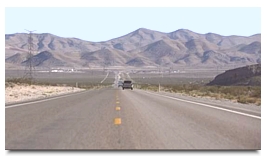 December 12, 2015 — EDITORIAL: Special session is all about Apex— This week's special legislative session is about so much more than Faraday Future, the electric car startup that picked North Las Vegas for a $1 billion, 3 million-square-foot manufacturing plant with the potential to forever transform Southern Nevada's economy. . . Apex has the space for those kinds of buildings. But the structures can't be built without suitable utility connections — especially a municipal water supply — Las Vegas Review Journal
December 12, 2015 — EDITORIAL: Special session is all about Apex— This week's special legislative session is about so much more than Faraday Future, the electric car startup that picked North Las Vegas for a $1 billion, 3 million-square-foot manufacturing plant with the potential to forever transform Southern Nevada's economy. . . Apex has the space for those kinds of buildings. But the structures can't be built without suitable utility connections — especially a municipal water supply — Las Vegas Review Journal
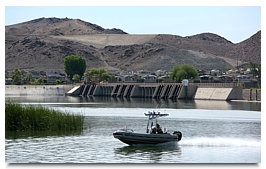 December 12, 2015 — Paris climate pact could limit Colorado River runoff reductions — The new agreement at the Paris climate talks to reduce greenhouse gas emissions in hopes of holding off future global warming will help - but hardly end - the Colorado River's chronic water supply problems, experts say. The 196 countries that met in .. — Arizona Daily Star [Mobil Link]
December 12, 2015 — Paris climate pact could limit Colorado River runoff reductions — The new agreement at the Paris climate talks to reduce greenhouse gas emissions in hopes of holding off future global warming will help - but hardly end - the Colorado River's chronic water supply problems, experts say. The 196 countries that met in .. — Arizona Daily Star [Mobil Link]
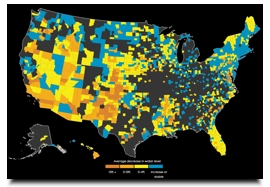 December 12, 2015 — Pumped beyond limits, many U.S. aquifers in decline . . . In a nationwide examination of the problem, USA TODAY and The Desert Sun analyzed two decades of measurements from more than 32,000 wells and found water levels falling in nearly two-thirds of those wells, with heavy pumping causing major declines in many areas. The analysis of U.S. Geological Survey data revealed that ... — DesertSun.com
December 12, 2015 — Pumped beyond limits, many U.S. aquifers in decline . . . In a nationwide examination of the problem, USA TODAY and The Desert Sun analyzed two decades of measurements from more than 32,000 wells and found water levels falling in nearly two-thirds of those wells, with heavy pumping causing major declines in many areas. The analysis of U.S. Geological Survey data revealed that ... — DesertSun.com
December 12, 2004 — When we had water - Bolder Dam — Photo by John Walker, GBWN Webmaster
[And in memory of Washoe Lake]
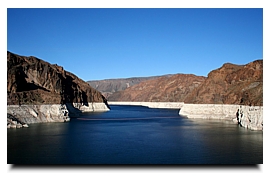 December 10, 2015 — Nature, Not Humans, Has Greater Influence on Water in the Colorado River Basin — AUSTIN, Texas — Researchers have found that the water supply of the Colorado River basin, one of the most important sources for water in the southwestern United States, is influenced more by wet-dry periods than by human use, which has been fairly stable during the past few decades — news.utexas.edu
December 10, 2015 — Nature, Not Humans, Has Greater Influence on Water in the Colorado River Basin — AUSTIN, Texas — Researchers have found that the water supply of the Colorado River basin, one of the most important sources for water in the southwestern United States, is influenced more by wet-dry periods than by human use, which has been fairly stable during the past few decades — news.utexas.edu
December 10, 2015 — [Las Vegas growth] Chinese-backed electric carmaker picks Nevada for $1B plant . . . It's expected to sit on 600 acres in North Las Vegas's Apex Industrial Park and bring 4,500 jobs to Nevada — Tucson.com
December 10, 2015 —
Faraday plant will survive on limited groundwater — for now — When state lawmakers convene later this month to consider an incentive package for Faraday Future, they won't be asked to find $150 million for a water pipeline to the factory site. Gov. Brian Sandoval said Thursday a pipeline from the Las Vegas Valley wasn't included in the deal because there is more than enough groundwater under the Apex industrial park to supply the $1 billion electric car plant — Las Vegas Review Journal
December 09, 2015 — Water Realities — There are some areas in which California's example is not always the best to follow—but conservation isn't one. Water districts there have to meet conservation targets or risk fines—and on the whole, the Golden State has voluntarily cut back water consumption by up to 31 percent since 2013, according to the Los Angeles Times. But here in Utah, all eyes are on a $1 billion Lake Powell Pipeline project — CityWeekly.net
December 09, 2015 — Clark County [Las Vegas] ranks high on new 'water hogs' list — A new online conservation campaign ranks Clark County as the nation's sixth largest "water hog," but local water officials are already turning their noses up at the findings — Las Vegas Review Journal [Mobil Link]
December 04, 2015 —
Balken: Water plan about reservoirs, rivers — A collaborative new plan to conserve water isn’t really about conservation; it’s about hydropower. The plan is called the “Colorado River Conservation Partnership,” and it was launched by the federal Bureau of Reclamation, the Southern Nevada Water Authority, Denver Water, the Central Arizona Project and the Metropolitan Water District of Southern California. Funded by BuRec and the water districts, the plan asks cities and farmers to use less water by fallowing fields, transitioning to more efficient crops, and encouraging frugal consumption — Summit Daily [Print PDF]
December 02, 2015 — When Levee Breaks: Are Cracks Showing in Foundation of Western US Water Law? — Drought in the American Southwest, especially in California, has resulted in significant impacts in the daily lives of people who, until recently, have been able to take for granted the water that comes out of the tap, through the irrigation gate, or down the river — The National Law Review
November 30, 2015 — Editorial: Lake Powell Pipeline must have realistic financing plan in place — It should not require a platoon of university economists, active and emeritus, to raise such an obvious point. But before the state of Utah floats maybe $1.8 billion in taxpayer-backed bonds to build the long-planned Lake Powell Pipeline, somebody had better have a pretty solid idea of how — and by whom — that debt will be repaid — Salt Lake Tribune [Related story — The Lake Powell Pipeline, Part III: An analysis of the proponents’ arguments]
November 28, 2015 — Op-ed: If Lake Powell pipeline is built, will Colorado River provide? — As the Utah Legislature gears up for the 2016 session, funding for a mammoth government project hangs over the heads of Utah taxpayers. The Lake Powell Pipeline project, the largest new diversion of the Colorado River estimated to cost anywhere from $2 billion to $3 billion, would pump water 2,000 feet uphill, over 140 miles of Southern Utah desert to provide additional water to Washington County, which has one of the worst records of water waste in the West — Salt Lake Tribune
November 24, 2015 — Letter: Lake Powell Pipeline a big gamble — sltrib.com
[Relatted Information] The Lake Powell Pipeline, An analysis of the proponents’ arguments — suindependent.com
November 23, 2015 — Water agency's land purchase rattles California farmers ? — The nation's largest distributor of treated drinking water became the largest landowner in a remote California farming region for good reason: The alfalfa-growing area is first in line to get Colorado River water — AP
 November 20, 2015 — Experts urge statewide water metering, conservation to fight drought — CARSON CITY — A state panel Friday finalized short-term and long-range recommendations for dealing with drought, from requiring meters on all water outlets in Nevada to stepping up drought monitoring and conservation efforts. The recommendations to be delivered to Gov. Brian Sandoval from the Nevada Drought Forum are a starting point. Much of the heavy lifting, if the governor pursues the findings, will come during the 2017 Legislature. "There's work to be done following this effort," said Leo Drozdoff, director of the Department of Conservation and Natural Resources appointed by the governor to chair the drought panel — Las Vegas Review Journal [Mobil Link]
November 20, 2015 — Experts urge statewide water metering, conservation to fight drought — CARSON CITY — A state panel Friday finalized short-term and long-range recommendations for dealing with drought, from requiring meters on all water outlets in Nevada to stepping up drought monitoring and conservation efforts. The recommendations to be delivered to Gov. Brian Sandoval from the Nevada Drought Forum are a starting point. Much of the heavy lifting, if the governor pursues the findings, will come during the 2017 Legislature. "There's work to be done following this effort," said Leo Drozdoff, director of the Department of Conservation and Natural Resources appointed by the governor to chair the drought panel — Las Vegas Review Journal [Mobil Link]
November 18, 2915— Will a new state plan solve Colorado's water troubles? On November 19, Colorado’s first state water plan will arrive on Governor John Hickenlooper’s desk. The final document is the product of discussions that began more than a decade ago in every corner of the state about how to use — and protect — Colorado’s rivers, lakes and aquifers — High Country News
 November 18, 2015 — Most groundwater is effectively a non-renewable resource, study finds — The water that supplies aquifers and wells that billions of people rely on around the world is, from a practical perspective, mostly a non-renewable resource that could run out in many places, a new Canadian-led study has found — cbc.ca
November 18, 2015 — Most groundwater is effectively a non-renewable resource, study finds — The water that supplies aquifers and wells that billions of people rely on around the world is, from a practical perspective, mostly a non-renewable resource that could run out in many places, a new Canadian-led study has found — cbc.ca
November 17, 2015 —
Drought, demography, and conservation in 21st century California — Dr. Glen MacDonald discusses California's changing climate and demography, and what the implications are for the future — mavensnotebook.com
 November 16, 2015 —
Rising temperatures explain drop in reservoirs better than drought — GRAND JUNCTION, Colo. – The Colorado River originates in Rocky Mountain National Park in Colorado, gathering water from tributary rivers that arise near Winter Park and Breckenridge, Vail and Crested Butte. A little more than halfway on its 1,450-mile route to the Pacific Ocean, the Colorado River gets blocked by a giant slab of concrete called Hoover Dam. This dam creates Lake Mead, the primary water source for Las Vegas — MountainTownNews.net
November 16, 2015 —
Rising temperatures explain drop in reservoirs better than drought — GRAND JUNCTION, Colo. – The Colorado River originates in Rocky Mountain National Park in Colorado, gathering water from tributary rivers that arise near Winter Park and Breckenridge, Vail and Crested Butte. A little more than halfway on its 1,450-mile route to the Pacific Ocean, the Colorado River gets blocked by a giant slab of concrete called Hoover Dam. This dam creates Lake Mead, the primary water source for Las Vegas — MountainTownNews.net
November 14, 2015 — Sharing the Colorado River — California, Arizona and Nevada have quarreled and litigated over Colorado River water for many decades. Now the states are slowly moving to a new model of cooperation. Once rare water shortages have become seemingly perpetual, posing a common danger. So instead of fighting to secure the most water for themselves, the states are increasingly focused on conserving water. That water is staying in Lake Mead, the linchpin to reliable supply in the three states. The more water they can store in this key reservoir, the better they are all protected — —SandiegoUnionTribune.com
November 12, 2015 — UC scientists test inexpensive way to capture El Niño rains — During California's rainy months, rivers often run high and excess water flows out into the ocean. Amid the worst drought in more than a century, all of that water lost? With an El Niño event expected to bring heavy rains this winter, isn't there an easy way to collect and store it? — SF Gate
November 11, 2015 — How Water Is Reshaping the West — NOVA NEXT
November 08, 2015 —
Feds delay decisions on new Colorado River diversions — The complex permitting process for a pair of new Colorado water supply projects has been delayed yet again, as federal agencies continue to study the impacts of new diversions from the Colorado River and enlarged reservoirs on the Front Range — SummitCountyVoice
November 05, 2015 — Water wars: How politics beat science in the West — In the 19th century, as settlers moved West, the gold seekers got most of the attention and publicity. But more of them traveled West for a less exciting reason—to farm. In many cases, it never occurred to them that the land might not be suitable for the purpose — NewsReview.com
November 04, 2015 — LA will soon use less imported H20, thanks to new water treatment — Los Angeles is getting a new, high-tech wastewater recycling plant to recharge groundwater supplies. It will help the region cut back on its use of expensive imported water — www.scpr.org
November 03, 2015 — Letter: Where is gov on water-smart solutions? — Where is gov on water-smart solutions?: Governor Sandoval created the Nevada Drought Forum in April of 2015. As water shortages have worsened in the southwest for over 10 years, why did he not create the forum a couple months after first being elected in 2010? When he served in the Nevada Assembly in 1995, did he not know there were multi-decade periods of drought? Has he not heard of the Lake Mead bathtub ring over the past decade? — elkodaily.com [Print Letter]
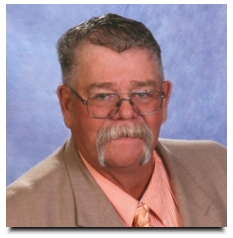 October 27, 2015 — New committee will study Nevada water issues CARSON CITY – The state Legislative Commission today agreed to appoint a special committee to study water issues and present recommendations to the 2017 session of the Legislature.“We have to take a long, hard look at water or the lack of it,” said Sen. Pete Goicoechea, R-Eureka — Las Vegas sun
October 27, 2015 — New committee will study Nevada water issues CARSON CITY – The state Legislative Commission today agreed to appoint a special committee to study water issues and present recommendations to the 2017 session of the Legislature.“We have to take a long, hard look at water or the lack of it,” said Sen. Pete Goicoechea, R-Eureka — Las Vegas sun
October 26, 2015 — University economists challenge Lake Powell Pipeline payback proposal — f Washington and Kane counties were to actually borrow the estimated $1.4 to $1.8 billion it will take to build the Lake Powell Pipeline, paying it back would become so expensive for local water users that there wouldn't even be any demand for the water, according a group of economists requesting more analysis of the proposed project — theSpectrum.com
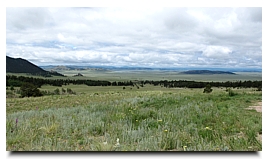 October 26, 2015 — Along the Colorado River, Ranchers Square off Against Cities Over Water Rights The plains of Colorado's Western Slope were lush after heavy rains last spring. But a trend towards warmer, drier weather may soon leave the land parched. For rancher Kathleen Curry, the time for hollow reassurances is over. From her chair at the linoleum-topped kitchen table, she looks out to the view that a wide window frames: a small patch of lawn, a lattice of bleached wooden fence and beyond, hills that rise out of the flat plains, waves of green that fade to parched brown — HuffingtonPost.com
October 26, 2015 — Along the Colorado River, Ranchers Square off Against Cities Over Water Rights The plains of Colorado's Western Slope were lush after heavy rains last spring. But a trend towards warmer, drier weather may soon leave the land parched. For rancher Kathleen Curry, the time for hollow reassurances is over. From her chair at the linoleum-topped kitchen table, she looks out to the view that a wide window frames: a small patch of lawn, a lattice of bleached wooden fence and beyond, hills that rise out of the flat plains, waves of green that fade to parched brown — HuffingtonPost.com
October 23, 2015 — Lawsuit Threatened Over Failure to Protect Endangered Nevada Fish — LAS VEGAS— The Center for Biological Diversity today notified the U.S. Fish and Wildlife Service and Bureau of Land Management of its intent to sue the agencies for allowing groundwater pumping that will feed Las Vegas sprawl but would dry up the springs and aquifers that sustain the Moapa dace. The dace is an endangered fish found only in the headwater springs of the Muddy River, about 60 miles north of Las Vegas in the Moapa Valley Wildlife Refuge — Center for Biological Diversity
October 23, 2015 — Ex-federal official: Dams are ‘dinosaurs’ — MINDEN: Dams and other surface storage are “dinosaurs.”
That’s according to Daniel P. Beard, the former commissioner of the U.S. Bureau of Reclamation, the government agency responsible for building and maintaining 475 dams across the country — Lake Tahoe News
October 20, 2015 — Several years after going into ranching business, SNWA still irks neighbors — In the coming weeks, the Southern Nevada Water Authority will prepare its livestock for the harsh winter in the Great Basin. Sheep and cows will shuffle to different ranges or begin their trek to slaughterhouses — Las Vegas Sun
October 16, 2015 — Santa Fe Water Supply Study: A dry future? Water managers say plans to keep taps flowing are underway — A recent study by the U.S. Bureau of Reclamation sees Santa Fe’s water supply as inadequate to meet future needs. But local water managers still see the glass as half full. According to a study of the Santa Fe Basin, by 2055, the city-county water system that serves residents of the capital city and northern Santa Fe County would come up about 5,155 acre-feet of water per year short – “the amount of water that provides for more than 20,000 people,” the report states — AbqJournal.com
October 15, 2015 — This Devastating Chart Shows Why Even a Powerful El Niño Won’t Fix the Drought — In California, news of a historically powerful El Niño oceanic warming event is stoking hopes that winter rains will ease the state's brutal drought. But for farmers in the Central Valley, one of the globe's most productive agricultural regions, water troubles go much deeper—literally—than the current lack of precipitation. That's the message of an eye-popping report from researchers at the US Geological Survey. This chart tells the story: — Mother Jones [Mobil Link]
October 12, 2015 —
Researchers say Nevada alpine lakes may be warmest in 7,000 years — The alpine lakes high in Nevada's only national park are warmer now than they have been for thousands of years, according to findings by a team from Ohio State University. For the past decade, the researchers have conducted a variety of studies at Great Basin National Park, 300 miles northeast of Las Vegas, aimed at reconstructing the climate record for the area over the past 7,000 or so years — Las Vegas Review Journal [Mobil Link]
October 12, 2015 — Scholars urge more research on future of Colorado River — SALT LAKE CITY (AP) — A coalition of scholars across the West is urging the federal government to partner with the National Academy of Sciences to study the future of the Colorado River, including if climate change is leading to reduced stream flow — Denverpost.com
October 10, 2015 — Richard Svindland: Desalination project makes progress — This week, the California Coastal Commission voted to allow operation of California American Water’s test slant well to resume. The test slant well is designed to determine the feasibility of using slant wells as a seawater intake system for a desalination project to serve the Monterey Peninsula region. The commission’s decision affirms that state permitting agencies are committed to requiring desalination project proponents to determine, and then use, the most environmentally protective intake system available — MontereryHerld.com
October 08, 2015 — This year’s El Niño still looks like a whopper — Federal forecasters on Thursday reinforced expectations of a strong El Niño this winter, saying there’s a 95 percent chance the burly weather phenomenon, often linked to rain in California, sticks around until spring — SF Gate
October 08, 2015 — In last year, Lake Mead dropped below 10 million acre feet for first time — The ongoing drought continues to take a toll on the main supply of water for Las Vegas. For the first time since the 1930s, Lake Mead ended the "water year" below 10 million acre feet of storage, according to John Fleck, a writer in residence at the University of New Mexico's Water Resources Program — Las Vegas Sun [Mobil Link]
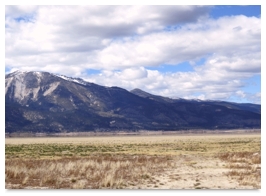 October 03, 2015 — Drought talks could bring legislative showdown in Nevada — CARSON CITY: Everyone and every living thing needs water. The challenge in Nevada is how best to prepare and share when Mother Nature turns off the taps. An unprecedented statewide discussion in late September about drought and water rights in Nevada could signal a looming showdown in the 2017 Legislature over water management
October 03, 2015 — Drought talks could bring legislative showdown in Nevada — CARSON CITY: Everyone and every living thing needs water. The challenge in Nevada is how best to prepare and share when Mother Nature turns off the taps. An unprecedented statewide discussion in late September about drought and water rights in Nevada could signal a looming showdown in the 2017 Legislature over water management
. . . "We need to tie growth more tightly to the wet water we have available," said Howard Watts with Great Basin Water Network, a group that advocates balancing water resources needed for human needs with protection of plants and animals. In many areas of Nevada, water rights recorded on paper exceed the "wet" water actually available — Las Vegas Review Journal [Print PDF] [Mobil Link]
October 02, 2015 — Cash offered to frugal Colorado River water users — SALT LAKE CITY: Protracted drought over the last four years and nagging uncertainty over how Lake Powell will fare in 2016 are prompting a cash-for-conservation program to test how much water can be saved in the Colorado River — Desert News
October 01, 2015 —  How Does Selling H2O To Southern California Help Southern Nevada? — Here in the desert southwest, where the drought is beginning to make residents see water as a commodity more valuable than gold, this might surprise you. A deal that transfers some 150,000 acre-feet of water from the Southern Nevada Water Authority to Southern California is seen as a positive move by Moody’s, the global bond credit rating business — KNPR Public Radio How Does Selling H2O To Southern California Help Southern Nevada? — Here in the desert southwest, where the drought is beginning to make residents see water as a commodity more valuable than gold, this might surprise you. A deal that transfers some 150,000 acre-feet of water from the Southern Nevada Water Authority to Southern California is seen as a positive move by Moody’s, the global bond credit rating business — KNPR Public Radio
September 30, 2015 — As the Colorado River Runs Dry, Impact Investors Seek Water Solutions — The Colorado River, which supplies water to 35 million people and four million acres of irrigated agriculture across seven states (plus two in Mexico), is running dry after 15 years of drought. That's both a problem and an opportunity for impact investors — Huffington Post
September 28, 2015 — Elko, rest of Nevada need funds for water projects — LAS VEGAS (AP): A milestone pipeline project to keep drawing water from a shrinking Lake Mead is just one of many efforts on a long list of projects aimed at keeping plentiful and cheap tap water flowing in the nation's most arid state. Officials call the $817 million "Third Straw" to Las Vegas the most expensive single water works project ever in Nevada — AP
September 25, 2015 — Ken Salazar sees water, energy solutions on horizon — As far as Ken Salazar is concerned, California needs to start living within its water means. In a wide-ranging interview with The Desert Sun, the former Interior secretary said California’s water future will depend mostly on finding ways to use less, not creating new supplies. He also praised President Barack Obama for promoting both clean energy development and domestic oil and gas drilling — The Desert Sun
September 25, 2015 — New Lake Mead straw now delivering water to Las Vegas Valley — The valley's water system entered a new age Friday, as the first drops from a critical new straw at Lake Mead entered the community's distribution system. The Southern Nevada Water Authority's new, $817 million intake went on line and began delivering water to the Alfred Merritt Smith Water Treatment Plant near Lake Mead about 1 p.m. Las Vegas Review Journal
 September 24, 2015 — Governor's Drought Forum — Great Basin Water Network‘s Howard Watts stated his appreciation to be “in a more relaxed environment” where he’s not battling many of the folks in this room at a #NVLeg hearing or in court. He then thanked SNWA for its work on “The Third Straw”… As there looks to be no remaining excuse for any Snake Valley water grab. Watts reiterated Davis’ call for greater conservation and the end of “use it or lose it”. He then called for fairer water rates that ensure the biggest water users pay their fair share and a new statewide water plan that properly addresses this large statewide problem.
September 24, 2015 — Governor's Drought Forum — Great Basin Water Network‘s Howard Watts stated his appreciation to be “in a more relaxed environment” where he’s not battling many of the folks in this room at a #NVLeg hearing or in court. He then thanked SNWA for its work on “The Third Straw”… As there looks to be no remaining excuse for any Snake Valley water grab. Watts reiterated Davis’ call for greater conservation and the end of “use it or lose it”. He then called for fairer water rates that ensure the biggest water users pay their fair share and a new statewide water plan that properly addresses this large statewide problem.
Watts also called for smart storage, meaning no new dams, no new reservoirs, and (yes to) new recharging to groundwater. And yes, Watts also requested proper growth management strategy that ties growth to water. Watts then addressed the issue of California coastal desalination. He sounded supportive, calling it a “responsible choice”— Let'sTalkeNevada [More Coverage — Public Service News ]
 September 24, 2015 — Southern Nevada will have access to enough water for decades, official says — CARSON CITY: The water needed for the Las Vegas area for more than 40 years will be available, a water official said Tuesday, but Southern Nevada will continue its fight to pump millions of gallons a year from rural Nevada. Our community has told us to get the shovel ready but don’t start digging a hole yet,” said John Entsminger, general manager of the Southern Nevada Water Authority — Las Vegas Sun [Mobil Link]
September 24, 2015 — Southern Nevada will have access to enough water for decades, official says — CARSON CITY: The water needed for the Las Vegas area for more than 40 years will be available, a water official said Tuesday, but Southern Nevada will continue its fight to pump millions of gallons a year from rural Nevada. Our community has told us to get the shovel ready but don’t start digging a hole yet,” said John Entsminger, general manager of the Southern Nevada Water Authority — Las Vegas Sun [Mobil Link]
September 23, 2015 — Officials: Revise water rules —State and local water rules need revising in order to deal with Nevada’s water scarcity. That was the consensus of water authorities and providers who spoke on a panel Tuesday during the second day of the Governor’s Drought Summit. The three-day summit was convened by Gov. Brian Sandoval to examine and find ways to cope with the state’s ongoing drought — Nevada Appeal [Print PDF]
September 22, 2015 — Tweaks to Nevada water law pitched at drought summit — CARSON CITY: Managers and overseers of public water systems joined others Tuesday in recommending tweaks to Nevada water law to reward conservation and spread responsibility to conserve during times of drought. "I think ultimately water rights management has to evolve from the strict prior appropriation to more of a paradigm of shared risk," said John Entsminger, general manager of Southern Nevada Water Authority — Las Vegas Review Journal [Mobil Link]
September 22, 2015 — California seeks to build one of world's largest recycled water programs — The Metropolitan Water District of Southern California is in talks with Los Angeles County sanitation districts about developing what could be one of the largest recycled water programs in the world — LA Times [Related Story]
September 22, 2015 — Water Conservation, Brought to You by Las Vegas — To understand just how serious Las Vegas has gotten about its water in the past 15 years, consider this scenario that Bronson Mack, who oversees water resources and operations in at Southern Nevada Water Authority, painted for me the other day — OutSideOnline.com
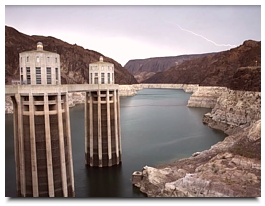 September 19, 2015 — Report: Vegas has enough water to add 1 million residents — The Las Vegas Valley has enough water to support 1 million more residents, and it should be able to weather at least the next 20 years before any permanent new supplies are needed, according to the Southern Nevada Water Authority's revised 2015 resource plan — Las Vegas Review Journal [Mobil Link] [Print PDF]
September 19, 2015 — Report: Vegas has enough water to add 1 million residents — The Las Vegas Valley has enough water to support 1 million more residents, and it should be able to weather at least the next 20 years before any permanent new supplies are needed, according to the Southern Nevada Water Authority's revised 2015 resource plan — Las Vegas Review Journal [Mobil Link] [Print PDF]
2015 SNWA Water Resource Plan: The plan, approved by the SNWA Board of Directors on Sept. 17, 2015, provides a comprehensive overview of projected water demands in Southern Nevada, as well as the resources available to the SNWA to meet those demands over time.
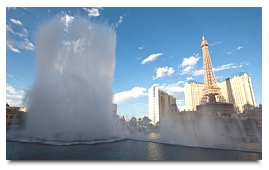 September 22, 2015 — Water Conservation, Brought to You by Las Vegas — To understand just how serious Las Vegas has gotten about its water in the past 15 years, consider this scenario that Bronson Mack, who oversees water resources and operations in at Southern Nevada Water Authority, painted for me the other day — OutSideOnline.com
September 22, 2015 — Water Conservation, Brought to You by Las Vegas — To understand just how serious Las Vegas has gotten about its water in the past 15 years, consider this scenario that Bronson Mack, who oversees water resources and operations in at Southern Nevada Water Authority, painted for me the other day — OutSideOnline.com
September 17, 2015 —
Chances of historic El Niño growing for California — Hopes for a wet winter and spring for drought-parched California grew Thursday as researchers predicted that there’s at least a 95 percent chance of a historic El Niño on the way — SFGate.com [Related Information — California Epic Drought Leads to Lowest Snowpack in 500 Years]
September 17, 2015 — Colorado finalizes climate plan — Colorado’s new climate plan calls for an all-hands-on-deck approach, with various state agencies working together, and with the public, to address the potential impacts of rising temperatures — SummitCountyVoice.com
September 17, 2015 — Authority approves leasing water to California —Drought-stricken cities in Southern California will soon get some help courtesy of the Southern Nevada Water Authority. Authority board members on Thursday approved plans to lease 150,000 acre-feet of water to California from the Las Vegas Valley's reserves in the coming year. Pending approval from its board, the Metropolitan Water District of Southern California will pay the authority almost $44.4 million for the water, which equates to about a six-month supply for the Las Vegas Valley — Las Vegas Review Journal
September 15, 2015 — SNWA could lease water to drought-stricken California — The Southern Nevada Water Authority would dip into its reserves to lease water to drought-stricken California under a plan slated for a vote by the agency's board Thursday. Under the deal, the Metropolitan Water District of Southern California would pay the authority almost $44.4 million for 150,000 acre-feet of water, half of Nevada's annual share of the Colorado River [Print PDF] — Las Vegas Review Journal
September 12, 2015 — Study: Colorado River shortage could hit Arizona hard — A shortage of Colorado River water would affect Arizona and the Southwest more than many people previously believed, a new study says. Called “The Bathtub Ring” after Lake Mead’s whitish coating, the study examined potential side effects of a Colorado River supply shortfall. It warns that electricity costs for Hoover Dam power customers would rise sharply, that visitation to Lake Mead could tumble and that California, not just Arizona, would suffer from an early shortage — Tucson.com
September 10, 2015 — Water authority's new straw at lake mead starts to fill — After seven years of construction, the Las Vegas Valley's new straw into Lake Mead now has some water in it. General contractor Vegas Tunnel Constructors began sending the first 11 million gallons into the 3-mile tunnel beneath the bed of the lake Thursday afternoon, marking the latest milestone for a complicated and risky $817 million project on track for completion within the next month or so. — Las Vegas Review Journal [Mobil Link]
 September 09, 2015 — Commentary: Nevada agriculture is conservation partner, not enemy — TOM BAKER — Last month, the Nevada Drought Forum asked to hear from agriculture about the impacts of the ongoing drought, what actions farmers and ranchers have taken to deal with those impacts, and what actions we’d like to see from the state in the short and long term. As we head into this month’s state Drought Summit, it’s important to correct some misconceptions. Agriculture, especially in California, has been in the media hot seat lately for the amount of water it uses. Pick your enemy: almonds or alfalfa, milk, meat, or melons. Anything but drip irrigation is considered a waste of water. I was heartened to see that in recent public opinion surveys, residents haven’t bought into these skewed perspectives, and support conservation to preserve local agriculture and the environment — Elko Daily.com [Print PDF]
September 09, 2015 — Commentary: Nevada agriculture is conservation partner, not enemy — TOM BAKER — Last month, the Nevada Drought Forum asked to hear from agriculture about the impacts of the ongoing drought, what actions farmers and ranchers have taken to deal with those impacts, and what actions we’d like to see from the state in the short and long term. As we head into this month’s state Drought Summit, it’s important to correct some misconceptions. Agriculture, especially in California, has been in the media hot seat lately for the amount of water it uses. Pick your enemy: almonds or alfalfa, milk, meat, or melons. Anything but drip irrigation is considered a waste of water. I was heartened to see that in recent public opinion surveys, residents haven’t bought into these skewed perspectives, and support conservation to preserve local agriculture and the environment — Elko Daily.com [Print PDF]
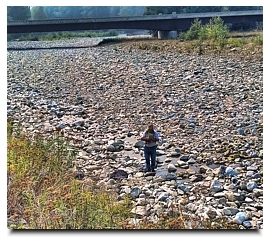 September 08, 2015 — Low 2015 Snowpack and River Flows Studied to Provide Insight Into Future Droughts — SEATTLE – U.S. Geological Survey hydrologic technicians are currently taking measurements from hundreds of streams and rivers across the western United States as part of a low flow study — USGS
September 08, 2015 — Low 2015 Snowpack and River Flows Studied to Provide Insight Into Future Droughts — SEATTLE – U.S. Geological Survey hydrologic technicians are currently taking measurements from hundreds of streams and rivers across the western United States as part of a low flow study — USGS
September 03, 2015 — San Diego is a salt mover and shaker in desalination campaign — San Diego may be known as "America's Finest City," but — at least this week — it's also the epicenter of the desalination and water reuse movement. More than a thousand water experts from around the globe are gathered at the waterfront convention center for the International Desalination Assn. World Congress — LA Times.com
 September 03, 2015 — Can El Niño end California drought? — The excitement about a potentially rain-bearing El Niño is building, and hopes for a swift end to California’s ongoing drought are multiplying. At the same time, many of us who have worked extensively on water issues in the state fear the momentum and progress made on much-needed water reforms will be lost — EarthSky.org
September 03, 2015 — Can El Niño end California drought? — The excitement about a potentially rain-bearing El Niño is building, and hopes for a swift end to California’s ongoing drought are multiplying. At the same time, many of us who have worked extensively on water issues in the state fear the momentum and progress made on much-needed water reforms will be lost — EarthSky.org
September 03, 2015 — Nevada Supreme Court hears arguments in water fight — CARSON CITY: Las Vegas and rural Nevada have been battling since 1989 over efforts to pump millions of gallons of water a year to Southern Nevada. Another chapter played out before the Nevada Supreme Court on Wednesday over the decision of state Engineer Jacob King to permit the Southern Nevada Water Authority to pipe 61,000 acre feet of water from Spring Valley in White Pine County — Las Vegas Sun [Readers Note: GBWN is Not a party to this action] [Mobil Link]
August 31, 2015 — Northern Nevada farmers adapt to severe drought — CARSON CITY: Fisheries are drying up and fields lie fallow as the lingering drought takes its toll in Northern Nevada, where the lack of water needed to support rural livelihoods is causing tension between neighbors. Farmers and ranchers are being creative to try to survive the economic fallout for lack of water. They are experimenting with different crops, more efficient irrigation methods. One farmer is raising ducks and pheasants and turning part of his Lyon County farm into a hunting preserve to offset income losses — and be able to keep farming. "There are a lot of places in the state where this is the worst drought we've seen," said Jason King, state water engineer — Las Vegas Review Journal [Mobil Link] [Print - PDF]
August 31, 2015 — New Water Authority ads make saving water sexy — VIDEO — Las Vegas Review Jouranl
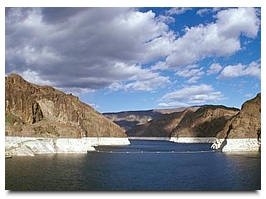 August 31, 2015 — Drought-Stricken Lake Mead Gets Boost From Preservation Program — From top to bottom, the mighty Colorado River is a 1,400-mile journey with 244,000 square miles of river basin that slakes thirst and grows crops for millions of residents in seven states—including 28 Indian tribes along the way. As one of the most heavily managed rivers in the United States, it is a bellweather for water supply in the Southwest, and it’s in serious trouble.
August 31, 2015 — Drought-Stricken Lake Mead Gets Boost From Preservation Program — From top to bottom, the mighty Colorado River is a 1,400-mile journey with 244,000 square miles of river basin that slakes thirst and grows crops for millions of residents in seven states—including 28 Indian tribes along the way. As one of the most heavily managed rivers in the United States, it is a bellweather for water supply in the Southwest, and it’s in serious trouble.
August 28, 2015 — Alternate ideas emerge for SNWA ‘water grab’ at Drought Forum— The final Nevada Drought Forum meeting for obtaining information was held on Aug. 19 in Sparks. Members of Nevada’s agricultural community, the Great Basin Water Network, Rural water organizations (including the Central Nevada Water Authority), and Tribes participated. Local input was given by Rick Spilsbury and Delaine Spilsbury. Rick Spilsbury suggested that the Southern Nevada Water Authority (SNWA) consider a profitable alternative to the Groundwater Development Project (the Watergrab). Rick’s idea was to install Photovoltaic (PV) solar arrays on Lake Mead — ElyNews.com [Print this story - PDF]
August 27, 2015 — The iffy fate of the Colorado River —On paper, the Colorado River is just fine. In reality, maybe not.
It all has to do with the water levels in two reservoirs that draw their supplies from the Colorado River: Lake Powell, on the border between Utah and Arizona; and Lake Mead, which gets its water from Lake Powell — The Colorado Independent
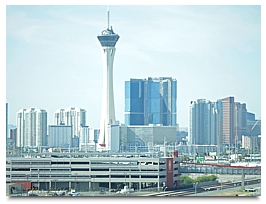 August 27, 2015 —
Learning from Sin City: How Las Vegas saves so much water
[LAS VEGAS HAS THE COACHELLA VALLEY BEAT AT CONSERVATION. WHAT IS SIN CITY DOING RIGHT?] The clock reads 7:30 a.m. as Perry Kaye climbs into a truck outside the Las Vegas Valley Water District office, a few miles from the Strip. It’s already a punishingly hot August day in Sin City, but Kaye is ready to do the job he’s done for the last decade: Patrol the city, looking for water wasters — DesertSun.com
August 27, 2015 —
Learning from Sin City: How Las Vegas saves so much water
[LAS VEGAS HAS THE COACHELLA VALLEY BEAT AT CONSERVATION. WHAT IS SIN CITY DOING RIGHT?] The clock reads 7:30 a.m. as Perry Kaye climbs into a truck outside the Las Vegas Valley Water District office, a few miles from the Strip. It’s already a punishingly hot August day in Sin City, but Kaye is ready to do the job he’s done for the last decade: Patrol the city, looking for water wasters — DesertSun.com
August 27, 2015 — Iron County sees a pipeline as its water savior – but not from Lake Powell — Cedar City: Forget the Lake Powell pipeline. In a community struggling with a depleted aquifer and land subsidence, the Central Iron County Water Conservancy District is banking on a 50-mile, $150 million pipeline to ease the area's water shortage. Still seven to 10 years away, the first phase of the pipeline project would pump up to 15,000 acre-feet of water — nearly 5 billion gallons — per year from Pine Valley in the West Desert to Cedar City — Salt Lake Tribune
August 22, 2015 — Federal river master: 'No shortages yet' on Colorado River — The Colorado River, the life-sustaining waterway of the American West, supplies water to nearly 40 million people. But years of drought and over-consumption have endangered the river, as well as the communities who rely on it for their livelihoods. Estevan López is commissioner of the Bureau of Reclamation, the federal agency responsible for water management in the West. Fault Lines spoke to him about the laws that govern the Colorado River, as well as why—when it comes to conservation—the federal government’s powers may be limited. An edited transcript of the conversation follows — America.Aljazeera.com
August 20, 2015 — Putting stock in trading water at forum — SPARKS: Water users in Eureka County’s Diamond Valley are going to soon be testing a market for trading water in the same way shares of companies are traded on a stock exchange. The goal is to try out a more flexible way for managing and using water that avoids some of the pitfalls of Nevada’s century old prior-appropriation water rights system, especially in areas such as Diamond Valley, where water is both seriously over pumped and over appropriated [Print PDF] — Nevada Appeal
August 20, 2015 — Drought panel told there’s forage, not water on Nevada range — Northern Nevada ranchers told a panel studying ongoing regional drought on Wednesday that there's a bumper crop of grass on the open range, and they want to be allowed to turn more cattle out to graze on it. Accounts of rains in recent months bringing wildflowers to northern parts of the state surfaced during a Nevada Drought Forum hosted by the state Department of Agriculture in Sparks — AP
August 19, 2015 — Losing Water, California Tries to Stay Atop Economic Wave — NyTimes.com
August 18, 2015 — Environmental group says limit growth to save water — CARSON CITY: The president of an environmental group has suggested limits on growth to conserve the state’s limited water resources and preserve residents’ quality of life. Abby Johnson, president of the Great Basin Water Network [GBWN], told Gov. Brian Sandoval’s Drought Commission that it should answer a simple question: “How many people can today’s proven water supplies and conservation techniques support?” [Print PDF] — Las Vegas Sun
Related Information —
   Read GBWN's President Abby Johnson's formal statement to Governor Sandoval's Drought Commission [3 Page PDF]
Read GBWN's President Abby Johnson's formal statement to Governor Sandoval's Drought Commission [3 Page PDF]
August 18, 2015 — Lake Mead water outlook improves — LAS VEGAS: Wet weather in May and June brought good news Monday from federal water managers keeping close tabs on the Colorado River water supply for about 40 million residents in seven Southwest U.S. states. The U.S. Bureau of Reclamation projected normal water deliveries to residents, farms, tribes and businesses at least through 2016 and possibly through 2017, water agency officials in Arizona, Nevada and California said — AP
August 14, 2015 — How California Is Winning the Drought [The state’s scorching summer of 2015 is showing us that we know what to do when it comes to conserving water — we just have to do it.] — FOR California, there hasn’t ever been a summer quite like the summer of 2015. The state and its 39 million residents are about to enter the fifth year of a drought. It has been the driest four-year period in California history — and the hottest, too. Yet by almost every measure except precipitation, California is doing fine. Not just fine: California is doing fabulously — NyTimes.com
 August 09, 2015 — [SNWA]
water authority in sheep trouble with park service — For years, sheep from a ranch in White Pine County have been grazing illegally inside Great Basin National Park, but don't expect some Bundy-style government roundup. This is no rogue rancher flouting federal authority. These animals belong to the Southern Nevada Water Authority. "It's been going on for a while now, and we're still having trouble with trespass sheep," park superintendent Steve Mietz said. Since 2009, the National Park Service has been telling the Las Vegas Valley's wholesale water supplier to keep its livestock out of the roughly 77,000-acre park in the Snake Mountains 300 miles northeast of Las Vegas — Las Vegas Review Journal [Mobil Link] [Print PDF]
August 09, 2015 — [SNWA]
water authority in sheep trouble with park service — For years, sheep from a ranch in White Pine County have been grazing illegally inside Great Basin National Park, but don't expect some Bundy-style government roundup. This is no rogue rancher flouting federal authority. These animals belong to the Southern Nevada Water Authority. "It's been going on for a while now, and we're still having trouble with trespass sheep," park superintendent Steve Mietz said. Since 2009, the National Park Service has been telling the Las Vegas Valley's wholesale water supplier to keep its livestock out of the roughly 77,000-acre park in the Snake Mountains 300 miles northeast of Las Vegas — Las Vegas Review Journal [Mobil Link] [Print PDF]
August 04, 2015 — Henderson water rates rise as Lake Mead levels fall — Joining other local water districts, Henderson approved an added fee on water bills Tuesday to help pay for a new pumping station at Lake Mead. The money will go to the Southern Nevada Water Authority, not the city — Las Vegas Review Journal [Mobil Link]
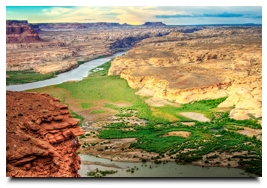 August 02, 2015 — The Colorado River is crucial to the West's water supply – and harnessing it was a feat — Water supply in the West isn’t only about rain, or the lack thereof. A good deal of water scarcity issues have to do with decades-old policy on water issues and entrenched infrastructure. It’s a convoluted situation, and reporter Abrahm Lustgarten of ProPublica is part of a team that is working to make sense and put broader perspective on the Western water crisis and the central role of the Colorado River. Their findings are being reported in a series called, “Killing the Colorado.” — PRI
August 02, 2015 — The Colorado River is crucial to the West's water supply – and harnessing it was a feat — Water supply in the West isn’t only about rain, or the lack thereof. A good deal of water scarcity issues have to do with decades-old policy on water issues and entrenched infrastructure. It’s a convoluted situation, and reporter Abrahm Lustgarten of ProPublica is part of a team that is working to make sense and put broader perspective on the Western water crisis and the central role of the Colorado River. Their findings are being reported in a series called, “Killing the Colorado.” — PRI
Agust 01, 2015 — Seven Things That Might Surprise You About California's Drought — Residents of California are understandably worried about the state’s drought, as a Care2 survey confirmed earlier this year. But as I read more about what’s going on in my state, I discovered several pieces of misinformation, or at least not-quite-accurate reports. Here’s a list of seven things that might surprise you — Truth-out.org
July 29, 2015 — I-Team: Former SNWA workers says they lied about Ranch costs — You may not know it, but everyone in southern Nevada has an ownership stake in a ranching empire located in east-central Nevada. The ranches were purchased years ago by the Southern Nevada Water Authority as part of its plan to go after billions of gallons of rural groundwater. The water agency spent tens of millions of public dollars to buy the ranches, and even more money to operate them. Now, a former accountant for SNWA alleges the water agencies have been lying about how much money they spend each month to keep the ranches open — LasVegasNow.com [Print - PDF]
July 29, 2015 — Colorado River conservation program could get financial boost — Water officials insist a pilot program designed to save Colorado River water and boost Lake Mead and Lake Powell is off to such a promising start that they are already looking to pour more money into it. The Southern Nevada Water Authority is poised to chip in as much as $1.5 million on top of the $2 million it already committed to the Colorado River System Conservation Program, which was established last year among the U.S. Bureau of Reclamation and the water suppliers from the four largest communities served by the Colorado — Las Vegas Review Journal [Mobil Link]
July 29, 2015 — Sen. Dianne Feinstein introduces $1.3-billion California drought-relief bill — Sen. Dianne Feinstein filed her long-awaited legislative response to California's water crisis on Wednesday, hoping to broker a compromise that has eluded Congress through four years of fallow fields and brown lawns. Feinstein's proposal would funnel $1.3 billion over the next decade to storage, desalination and other projects. Her plan is in marked contrast to one approved by the GOP-controlled House, which would pump more water to San Joaquin Valley growers by rolling back environmental protections — LA Times
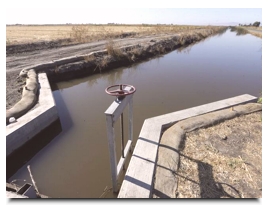 July 29, 2015 — Drought now Californians' top concern, poll finds — Concern over California’s drought is “extremely high and intensifying,” as a majority of state residents now believe global warming has contributed to the crisis, according to polling data released this week. As residents struggle to meet mandated cuts in urban water use and state agriculture braces for up to $2.2 billion in losses this year, voter concern over the drought has now eclipsed worry over jobs, the economy and eduction, according to researchers — LA Times
July 29, 2015 — Drought now Californians' top concern, poll finds — Concern over California’s drought is “extremely high and intensifying,” as a majority of state residents now believe global warming has contributed to the crisis, according to polling data released this week. As residents struggle to meet mandated cuts in urban water use and state agriculture braces for up to $2.2 billion in losses this year, voter concern over the drought has now eclipsed worry over jobs, the economy and eduction, according to researchers — LA Times
July 27, 2015 — Study highlights new water-saving tool to help colorado river basin — CARSON CITY– A new study suggests that government entities in the seven-state, drought-stricken Colorado River Basin could save 40,000 acre-feet of water each year using a process called performance contracting to improve conservation efforts. Another 24,000 acre-feet, including 1,400 acre-feet in Nevada, could be saved by using the same process to install high-tech water meters, the study says. The savings would come about from additional conservation by customers, who would see their bills increase as their usage was more accurately measured — Las Vegas Review Journal [Mobil Link]
July 27, 2015 — Major upgrades in Colorado water plan — The ongoing effort to devise a state water plan is unprecedented in Colorado, but you only have to consider the drought in California to understand why a plan is so important — DenverPost.com
July 22, 2015 — Water's impact on the Southern Nevada community — LAS VEGAS (KSNV News3LV) – Could there be a day when Lake Mead runs dry? Las Vegas is a city with an endless thirst, and there's a reason. Our tourism-based economy grows where water flows, but are the days numbered? “What would it be like to live in a valley with a dead lake? That new straw can pump so low that basically the river would stop flowing past hoover dam and into California,” said Howard Watts with the Great Basin Water Network. Howard is talking about the so-called "third straw" that's been trenched 3 miles under the shore of Lake Mead — News3LV.com
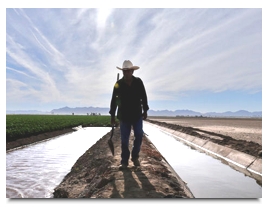 July 18, 2015 — Shrinking Colorado River is a growing concern for Yuma farmers — and millions of water users — The Colorado River begins as snowmelt in the Rocky Mountains and ends 1,450 miles south in Mexico after making a final sacrifice to the United States: water for the farm fields in this powerhouse of American produce. Throughout the winter, perfect heads of romaine, red-and-green lettuce, spinach and broccoli are whisked from the warm desert soil here onto refrigerated trucks that deliver them to grocery stores across the continent. If you eat a green salad between Thanksgiving and April, whether in Minnesota, Montreal or Modesto, odds are good that some of it was grown in or around Yuma — LA Times
July 18, 2015 — Shrinking Colorado River is a growing concern for Yuma farmers — and millions of water users — The Colorado River begins as snowmelt in the Rocky Mountains and ends 1,450 miles south in Mexico after making a final sacrifice to the United States: water for the farm fields in this powerhouse of American produce. Throughout the winter, perfect heads of romaine, red-and-green lettuce, spinach and broccoli are whisked from the warm desert soil here onto refrigerated trucks that deliver them to grocery stores across the continent. If you eat a green salad between Thanksgiving and April, whether in Minnesota, Montreal or Modesto, odds are good that some of it was grown in or around Yuma — LA Times
   How Water is apportioned in the Colorado Basin [graphic] How Water is apportioned in the Colorado Basin [graphic]
July 17, 2015 — Water managers dodge bullet with 'May miracle' rains — For drought watchers, it has become known as the May miracle. At a time when water levels in Lake Mead were getting so low that officials prepared for drastic cutbacks, it started raining. A series of powerful storms pummeled the mountains that feed the Colorado River, a key source of water for California, Arizona and Nevada — LA Times
 July 16, 2015 — Less Than Zero: Despite decades of accepted science, California and Arizona are still miscounting their water supplies — DEEP BENEATH the bleached-out, dusty surface of the drought-stricken West is a stash of water sequestered between layers of rock and sometimes built up over centuries.
Officials in the Colorado River basin states have long treated this liquid treasure as a type of environmental retirement account — an additional supply of water they can raid to get through the driest years and make up for the chronic overuse of the rivers themselves — ProPublica.org
July 16, 2015 — Less Than Zero: Despite decades of accepted science, California and Arizona are still miscounting their water supplies — DEEP BENEATH the bleached-out, dusty surface of the drought-stricken West is a stash of water sequestered between layers of rock and sometimes built up over centuries.
Officials in the Colorado River basin states have long treated this liquid treasure as a type of environmental retirement account — an additional supply of water they can raid to get through the driest years and make up for the chronic overuse of the rivers themselves — ProPublica.org
July 16, 2015 — Water officials seek grass-kicking new conservation message — "Get your head out of your grass"?: Yep, that‘s one slogan under consideration by the Southern Nevada Water Authority as it tries to refresh its conservation message, with the help of the world-renowned Las Vegas marketing agency that came up with "What Happens Here, Stays Here." The new campaign by R&R Partners promises to be just as edgy as the last one it produced for the authority, which featured an angry old lady kicking a wasteful water user right in his, um, drip irrigation system — Las Vegas Review Journal
[Mobil Link]
July 10, 2015 — Colorado shies from big fix as proliferating people seek more water — It looks like the ultimate water fix: Build a huge reservoir by Dinosaur National Monument and divert much of the Yampa River, then pump back 97 billion gallons a year through a 250-mile pipeline across the Continental Divide to Colorado's increasingly thirsty Front Range — Denverpost.com [Related Information — SaveTheColorado.org ]
 July 06, 2015 — Las Vegas completing last straw to draw Lake Mead water — LAS VEGAS: It took $817 million, two starts, more than six years and one worker's life to drill a so-called "Third Straw" to make sure glittery casinos and sprawling suburbs of Las Vegas can keep getting drinking water from near the bottom of drought-stricken Lake Mead. The pipeline, however, won't drain the largest Colorado River reservoir any faster. It's designed to ensure that Las Vegas can still get water if the lake surface drops below two existing supply intakes — AP
July 06, 2015 — Las Vegas completing last straw to draw Lake Mead water — LAS VEGAS: It took $817 million, two starts, more than six years and one worker's life to drill a so-called "Third Straw" to make sure glittery casinos and sprawling suburbs of Las Vegas can keep getting drinking water from near the bottom of drought-stricken Lake Mead. The pipeline, however, won't drain the largest Colorado River reservoir any faster. It's designed to ensure that Las Vegas can still get water if the lake surface drops below two existing supply intakes — AP
July 05, 2015 — California drought forces agency to rethink West’s water system FOLSOM, Calif. — Drew Lessard stood on top of Folsom Dam and gazed at the Sierra Nevada, which in late spring usually gush enough melting snow into the reservoir to provide water for a million people. But the mountains were bare, and the snowpack to date remains the lowest on measured record. “If there’s no snowpack, there’s no water,” said Lessard, a regional manager for the Bureau of Reclamation, the federal agency that built and operates a vast network of 476 dams, 348 reservoirs and 8,116 miles of aqueducts across the western United States — NyTimes.com
July 04, 2015 — [Calif.] Proposed reservoirs are no panacea for drought — The acute water shortages now hitting California have prompted many in Congress and the state Legislature to call for new surface reservoirs to reduce the impacts of future droughts. The reality is that new surface storage would have added only modestly to the state’s water supply — sacbe.com
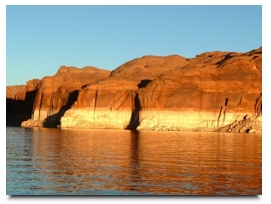 July 04, 2015 — Challenges to the Colorado River laid out at Ideas Fest ASPEN - Ranchers and farmers in western Colorado are incentivized to divert more water from the state’s streams and rivers than they need, an investigative reporter with ProPublica said at the Aspen Ideas Festival last week. Abrahm Lustgarten, whose series “Killing the Colorado” is now being published by the nonprofit news organization, said that Western water laws “have become so antiquated that they now actually undermine conservation. They actually incentivize people to waste their water and use it in inefficient ways.” — AspenJournalism.org
July 04, 2015 — Challenges to the Colorado River laid out at Ideas Fest ASPEN - Ranchers and farmers in western Colorado are incentivized to divert more water from the state’s streams and rivers than they need, an investigative reporter with ProPublica said at the Aspen Ideas Festival last week. Abrahm Lustgarten, whose series “Killing the Colorado” is now being published by the nonprofit news organization, said that Western water laws “have become so antiquated that they now actually undermine conservation. They actually incentivize people to waste their water and use it in inefficient ways.” — AspenJournalism.org
 listen to Abrahm Lustgarten's presentation (20:45). listen to Abrahm Lustgarten's presentation (20:45).
July 03, 2015 — Summerlin’s popularity continues to grow despite valley’s dwindling water supply — You hear those snide remarks about Summerlin, about its unique “roundabout” road intersections, about the well-manicured, palm tree-lined streets, the upscale homes in gated communities, the parks, the jogging trails and so much more. Then it all filters into some imaginary or maybe envious reference to those “snooty” or “smug” inhabitants of Summerlin. But the stark reality is this: The 22,500 acres of land that sit at the edge of Red Rock Canyon National Conservation Area, on the western rim of Las Vegas, form not only the most desirable master-planned community in the Southwest, they represent some of the most sought-after real estate by a growing percentage of home-seekers across America — RJ.com
[Mobile Link]
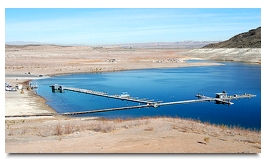 July 01, 2015 —
Lake Mead watch: As the Colorado dries up, will tourism? — Before Lake Mead was filled in 1936, there was little water to be had in the desert ecosystems of western Arizona and southern Nevada. But that changed after the Colorado River was impounded behind the Hoover Dam, creating the nation’s largest reservoir. By the 1950s, when Bob Gripentog, 64, was growing up on the shores of Lake Mead, water seemed abundant. In less than 50 years, Las Vegas grew from 40,000 people to 2 million — many of whom came to play on the reservoir, where Gripentog’s family ran a marina — High Country News
July 01, 2015 —
Lake Mead watch: As the Colorado dries up, will tourism? — Before Lake Mead was filled in 1936, there was little water to be had in the desert ecosystems of western Arizona and southern Nevada. But that changed after the Colorado River was impounded behind the Hoover Dam, creating the nation’s largest reservoir. By the 1950s, when Bob Gripentog, 64, was growing up on the shores of Lake Mead, water seemed abundant. In less than 50 years, Las Vegas grew from 40,000 people to 2 million — many of whom came to play on the reservoir, where Gripentog’s family ran a marina — High Country News
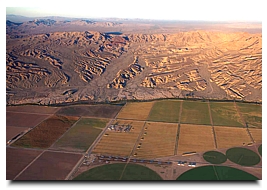 July 01, 2015 — In Drying Colorado River Basin, Indian Tribes Are Water Dealmakers — Mired in drought and torched by one of the hottest years ever measured, the seven states of the Colorado River Basin are acutely aware of how a desert can bully water supplies. They are not alone. In this cauldron of collaboration and competing interests is a collection of players who are just as significant for managing and responding to water scarcity but attract much less attention: the basin’s 29 federally recognized Indian tribes — CircleOfBlue.org [Interactive Map]
July 01, 2015 — In Drying Colorado River Basin, Indian Tribes Are Water Dealmakers — Mired in drought and torched by one of the hottest years ever measured, the seven states of the Colorado River Basin are acutely aware of how a desert can bully water supplies. They are not alone. In this cauldron of collaboration and competing interests is a collection of players who are just as significant for managing and responding to water scarcity but attract much less attention: the basin’s 29 federally recognized Indian tribes — CircleOfBlue.org [Interactive Map]
[Print PDF]
June 28, 2015 — Nevada water leader blasts Arizonans' anti-California rhetoric — How good are Arizona's legal rights to the Colorado River "if Lake Mead is at dead pool!!!!" asks Patricia Mulroy, the
former water boss for the Las Vegas area who has wielded enormous influence over the years over management of the
Colorado River and over Las Vegas' growth, water use and conservation — Tucson.com
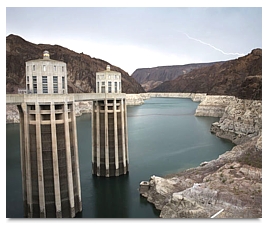 June 28, 2015 — Lake Mead decline below 1,075 feet is symbolic — If New Year’s Day had happened last week, the Central Arizona Project would have suffered the first water shortage in its 35-year history. That’s because Lake Mead — where CAP water is stored at the Nevada border — dropped below 1,075 feet elevationlate Tuesday, and stayed that way off and on the rest of the week. That’s the level at which the federal government is legally required to declare a shortage on the Colorado River, curtailing deliveries to Arizona farmers including some in northern Pima County — Tucson.com
June 28, 2015 — Lake Mead decline below 1,075 feet is symbolic — If New Year’s Day had happened last week, the Central Arizona Project would have suffered the first water shortage in its 35-year history. That’s because Lake Mead — where CAP water is stored at the Nevada border — dropped below 1,075 feet elevationlate Tuesday, and stayed that way off and on the rest of the week. That’s the level at which the federal government is legally required to declare a shortage on the Colorado River, curtailing deliveries to Arizona farmers including some in northern Pima County — Tucson.com
[Mobile Link]
June 25, 2015 — California’s Drought Is Part of a Much Bigger Water Crisis. Here’s What You Need to Know: — Propublica.org
- Why do I keep hearing about the California drought, if it's the Colorado River that we're "killing"?
- Just how bad is the drought in California right now?
- What about a lot of rain? Couldn't that end the drought in California and across the West?
- What do you mean by mismanagement?
- Wait — don't we all have equal water rights?
- So where is all this water going?
- What is California doing to address its water problems? Is it working?
- Will California cutbacks alleviate the larger Colorado River problem?
- I don't live in California or the West, so why is this my problem?
[Print PDF]
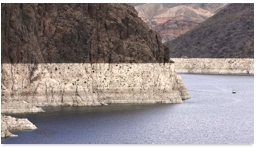 June 25, 2015 — How A Historical Blunder Helped Create The Water Crisis In The West [Transcript - PDF] — This is FRESH AIR. I'm Dave Davies, in for Terry Gross, who's off this week. We've heard a lot in recent years about the drought and water shortages in the West driven, many believe, by climate change. Our guest today, environmental reporter Abrahm Lustgarten, says those shortages are as much the product of mismanagement of our water resources as anything happening in the weather — NPR
June 25, 2015 — How A Historical Blunder Helped Create The Water Crisis In The West [Transcript - PDF] — This is FRESH AIR. I'm Dave Davies, in for Terry Gross, who's off this week. We've heard a lot in recent years about the drought and water shortages in the West driven, many believe, by climate change. Our guest today, environmental reporter Abrahm Lustgarten, says those shortages are as much the product of mismanagement of our water resources as anything happening in the weather — NPR  [36.56 min] [36.56 min]
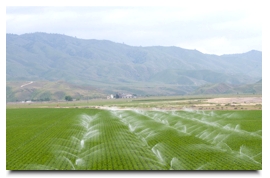 June 25, 2015 — 9 sobering facts about California’s groundwater problem — With an alarmingly dry winter and California reservoirs dropping fast, groundwater increasingly is keeping the state hydrated. It now accounts for about 60 percent of California’s water supply. But unlike its rivers, lakes and reservoirs, the state does not consider groundwater part of the public good. It does not regulate groundwater like it does surface water. Landowners can pump as much water as they want — RevealNews.org
June 25, 2015 — 9 sobering facts about California’s groundwater problem — With an alarmingly dry winter and California reservoirs dropping fast, groundwater increasingly is keeping the state hydrated. It now accounts for about 60 percent of California’s water supply. But unlike its rivers, lakes and reservoirs, the state does not consider groundwater part of the public good. It does not regulate groundwater like it does surface water. Landowners can pump as much water as they want — RevealNews.org
June 24, 2015 — Experts Name the Top 19 Solutions to the Global Freshwater Crisis — CircleOfBlue.org
June 24, 2015 — Western governors discuss water use changes — Some significant changes may be needed in the way water is used and protected across the West, according to a report issued Tuesday [24 Page PDF] as Nevada and adjoining states struggle with the impacts of protracted drought. The document, requested last year by Nevada Gov. Brian Sandoval, was released at the outset of the annual meeting of the Western Governors' Association at Lake Tahoe — Reno Gazette Journal
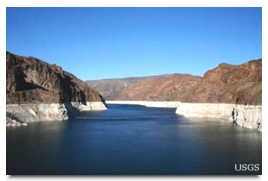 June 24, 2015 — ProPublica Investigates Colorado River Water Woes — PHOENIX - The investigative journalism group ProPublica has been taking an in-depth look at the water crisis in the West, in a series that is focused on the Colorado River. As part of the series Killing the Colorado, reporter Abrahm Lustgarten spent months interviewing people on all sides of the water-use debate, from farmers in Arizona to city leaders in Las Vegas. — ProPublica
June 24, 2015 — ProPublica Investigates Colorado River Water Woes — PHOENIX - The investigative journalism group ProPublica has been taking an in-depth look at the water crisis in the West, in a series that is focused on the Colorado River. As part of the series Killing the Colorado, reporter Abrahm Lustgarten spent months interviewing people on all sides of the water-use debate, from farmers in Arizona to city leaders in Las Vegas. — ProPublica
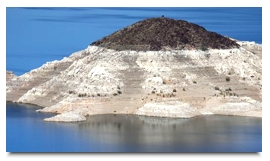 June 24, 2015 — Lake Mead sinks to record low, risking 2016 water shortage — Lake Mead sunk to a record low Tuesday night by falling below the point that would trigger a water-supply shortage if the reservoir doesn't recover by January. Water managers expect the lake's elevation level to rebound enough to ward off a 2016 shortage thanks to a wetter-than-expected spring. But in the long run, as a Bureau of Reclamation spokeswoman said, "we still need a lot more water." — USA Today
June 24, 2015 — Lake Mead sinks to record low, risking 2016 water shortage — Lake Mead sunk to a record low Tuesday night by falling below the point that would trigger a water-supply shortage if the reservoir doesn't recover by January. Water managers expect the lake's elevation level to rebound enough to ward off a 2016 shortage thanks to a wetter-than-expected spring. But in the long run, as a Bureau of Reclamation spokeswoman said, "we still need a lot more water." — USA Today
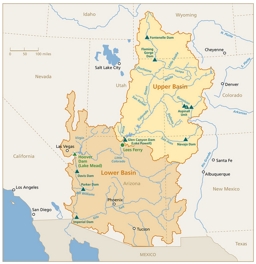 June 23, 2015 — [Wyoming] Green River could boost industrial complex dream — Legislators and industrialists hoping to build an energy complex in southwest Wyoming could more easily divert and use Green River water under a bill U.S. Sen. John Barrasso advanced last week. Barrasso heard no objections from a Bureau of Reclamation official against a plan to finish armoring the upstream face of Fontenelle Dam on the Green River in Sweetwater County near LaBarge. The bill would allow Wyoming to increase the amount of water drained from the 20-mile long reservoir —wyofile.com
June 23, 2015 — [Wyoming] Green River could boost industrial complex dream — Legislators and industrialists hoping to build an energy complex in southwest Wyoming could more easily divert and use Green River water under a bill U.S. Sen. John Barrasso advanced last week. Barrasso heard no objections from a Bureau of Reclamation official against a plan to finish armoring the upstream face of Fontenelle Dam on the Green River in Sweetwater County near LaBarge. The bill would allow Wyoming to increase the amount of water drained from the 20-mile long reservoir —wyofile.com
June 19, 2015 — The desalination conversation is getting downright salty — Top officials from the Southern Nevada Water Authority assure skeptics that, despite record drought throughout the West, steadily worsening conditions and rising demand, Southern Nevada has plenty of water for decades to come. Between conservation and reclamation, there’s no need to panic and start hand-wringing . . . Whatever drives your interest in a water future that includes desalination, there’s no shortage of opinions on the subject — John L. Smith, Las Vegas Review Jouranal
[Mobile Link]
June 17, 2015 — Drought, growth, complacency and the Review-Journal's water story — As a local journalist who’s covered water issues, I scratched my head while reading Jennifer Robison’s June 13 Review Journal story, “Water isn’t a worry when it comes to Las Vegas growth — Heidi Kyser, KNPR.org
June 17, 2015 — Lake Mead watch: six inches from the level that triggers cutbacks — Record rain across much of the West in May has provided Lake Mead with a much-needed boost – alleviating concerns about possible cutbacks in water deliveries from the nation's largest reservoir. But a month of rain does not solve Mead's falling water levels. For nearly two decades, the reservoir, which straddles the Arizona-Nevada border, has been shrinking due to prolonged drought and over-allocation — High Country News
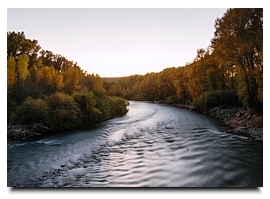 June 17, 2015 — Use It or Lose It: Across the West, Exercising One’s Right to Waste Water — HIGH IN THE ROCKY MOUNTAINS, snowmelt fills a stream that trickles down into Ohio Creek and then onward toward the Upper Gunnison River. From there, it tumbles through the chasms of the Black Canyon, joining the Colorado River, filling the giant Lake Powell reservoir, and, one day, flowing to Los Angeles. But before the water gets more than a few miles off the mountain, much of this stream is diverted into dirt ditches used by ranchers along the Ohio Creek Valley. Standing astride one of those ditches one day last fall, Bill Ketterhagen dug his boot soles against the concrete edge of a 5-foot-wide dam. He spun a steel wheel and opened a gate that allowed water to pour into his fields of hay crops — ProPublica.org
June 17, 2015 — Use It or Lose It: Across the West, Exercising One’s Right to Waste Water — HIGH IN THE ROCKY MOUNTAINS, snowmelt fills a stream that trickles down into Ohio Creek and then onward toward the Upper Gunnison River. From there, it tumbles through the chasms of the Black Canyon, joining the Colorado River, filling the giant Lake Powell reservoir, and, one day, flowing to Los Angeles. But before the water gets more than a few miles off the mountain, much of this stream is diverted into dirt ditches used by ranchers along the Ohio Creek Valley. Standing astride one of those ditches one day last fall, Bill Ketterhagen dug his boot soles against the concrete edge of a 5-foot-wide dam. He spun a steel wheel and opened a gate that allowed water to pour into his fields of hay crops — ProPublica.org
June 17, 2015 — Many of the world's water basins are being depleted, studies find — More than a third of the largest groundwater basins in the world are being depleted faster than they are getting replenished, and there are little to no accurate data showing just how much water is left in them, according to two new studies published Tuesday — LA Times
June 16, 2015 —[Opinion - Abby Johnson, resident of Carson City] Fresh Ideas: Public participation should be key in Drought Forum — The Governor’s Nevada Drought Forum is off to a disappointing start. At an April press conference, with parched and dusty Washoe Lake as a dramatic backdrop, Nevada Gov. Brian Sandoval announced the formation of the Nevada Drought Forum, created by Executive Order. The eight-man committee consists of state government department heads, university system reps and the new boss of Southern Nevada Water Authority (SNWA) — Nevada Appeal
June 16, 2015 — The Colorado River is not a water buffet. So why the 'first come, first serve' policy? — As water shortages grip California and the seven state Colorado River basin, many users feel no pain, while some face a complete curtailment. That’s because the water management system is not designed to be either efficient or equitable but consistent and predictable. And it is. — The Guardian.com
 June 16, 2015 —End of the Miracle Machines — Inside the Power Plant Fueling America’s Drought A COUPLE OF MILES outside the town of Page, three 775-foot-tall caramel-colored smokestacks tower like sentries on the edge of northern Arizona’s sprawling red sandstone wilderness. At their base, the Navajo Generating Station, the West’s largest power-generating facility, thrums ceaselessly, like a beating heart . . . The power generated enables a modern wonder. It drives a set of pumps 325 miles down the Colorado River that heave trillions of gallons of water out of the river and send it shooting over mountains and through canals — Propublica.org
June 16, 2015 —End of the Miracle Machines — Inside the Power Plant Fueling America’s Drought A COUPLE OF MILES outside the town of Page, three 775-foot-tall caramel-colored smokestacks tower like sentries on the edge of northern Arizona’s sprawling red sandstone wilderness. At their base, the Navajo Generating Station, the West’s largest power-generating facility, thrums ceaselessly, like a beating heart . . . The power generated enables a modern wonder. It drives a set of pumps 325 miles down the Colorado River that heave trillions of gallons of water out of the river and send it shooting over mountains and through canals — Propublica.org
June 15, 2015 — May showers bring better outlook for Colorado River, but no miracle — It wasn’t the “Miracle May” that some observers called it, but a month of downpours in Colorado and Utah did provide a significant boost to the outlook for the Colorado River. A terrible year became merely below average. 'Miracle' is probably a bit of an overstatement, but the unusually wet May did have a positive impact on water supply,” said Paul Miller, a senior hydrologist with the National Weather Service’s Colorado Basin River Forecast Center in Salt Lake City. Just a month ago, federal forecasters expected to see the Colorado at about 42 percent of its average flow. The U.S. Bureau of Reclamation’s latest monthly forecast, unveiled Monday afternoon, has upped the projection to 70 percent of average for the river that fills Lake Mead and supplies 90 percent of the Las Vegas Valley’s drinking water — Las Vegas Review Journal
[Mobile Link]
 June 15, 2015 — Beyond the Perfect Drought: California’s Real Water Crisis — The record-breaking drought in California is not chiefly the result of low precipitation. Three factors – rising temperatures, groundwater depletion, and a shrinking Colorado River – mean the most populous U.S. state will face decades of water shortages and must adapt — Environment 360 Yale
June 15, 2015 — Beyond the Perfect Drought: California’s Real Water Crisis — The record-breaking drought in California is not chiefly the result of low precipitation. Three factors – rising temperatures, groundwater depletion, and a shrinking Colorado River – mean the most populous U.S. state will face decades of water shortages and must adapt — Environment 360 Yale
[Mobile Link]
June 14, 2015 — Nev. fails to create rules to deal with drought — CARSON CITY: Nevada could pay a price for not making any substantive changes to its water laws during the 2015 legislative session. The possibility of a special session for the Legislature was discussed at the first meeting of the Nevada Drought Forum, a panel created in April by executive order of Gov. Brian Sandoval and consisting of several state agency heads and other water authorities — LakeTahoeNews.net
 June 14, 2015 — Israel Bringing Its Years Of Desalination Experience To California — Taking the salt out of seawater helped Israel move from the constant threat of drought to a plentiful supply of water, but Israel has learned that desalination is not the only answer — NPR
June 14, 2015 — Israel Bringing Its Years Of Desalination Experience To California — Taking the salt out of seawater helped Israel move from the constant threat of drought to a plentiful supply of water, but Israel has learned that desalination is not the only answer — NPR
 June 13, 2015 — Water isn’t a worry when it comes to Las Vegas growth — Forget everything you’ve heard about Southern Nevada’s water crisis. That includes:
June 13, 2015 — Water isn’t a worry when it comes to Las Vegas growth — Forget everything you’ve heard about Southern Nevada’s water crisis. That includes:
- Lake Mead will go dry within a decade.
- The Las Vegas Valley uses more Colorado River water than it has rights to.
- Resorts and homebuilders are irresponsibly throwing up water-guzzling homes and hotels.
- The city will run out of water completely and cease to exist in — fill in the blank — five, 10, 15, 30 years.
None of it is true. Fact is, Nevada has enough water not only for today, but for tomorrow — even a tomorrow that includes hundreds of thousands of new Las Vegans and millions more tourists — Las Vegas Review Jouranl
[Mobile Link]
June 13, 2015 — Return flows deserve all credit for las vegas’ water supply — On one hand, taking extra-long showers or letting the water run down the sink while you brush your teeth are bad habits that all desert dwellers really ought to break. On the other hand, none of that really matters when it comes to saving water in the Las Vegas Valley. That’s because virtually every drop of water washed down a drain or flushed down a toilet in this valley ends up being recycled under an all-important arrangement unlike any enjoyed by a major city served by the Colorado River — Las Vegas Review Journal [Mobile Link]
 June 13, 2015 — Desalination dawdling could leave southern Nevada high and dry — Drought-stricken Lake Mead keeps shrinking. The multibillion-dollar plan to pipe water from rural Nevada figures to be clogged in the courts for many years. But when I raised the subject of investing in desalination a few months ago, I got the strong feeling there wasn’t much active interest at the Southern Nevada Water Authority. Their experts knew all about it, of course, but they also recognized it was expensive and probably wouldn’t be needed for decades to come.
June 13, 2015 — Desalination dawdling could leave southern Nevada high and dry — Drought-stricken Lake Mead keeps shrinking. The multibillion-dollar plan to pipe water from rural Nevada figures to be clogged in the courts for many years. But when I raised the subject of investing in desalination a few months ago, I got the strong feeling there wasn’t much active interest at the Southern Nevada Water Authority. Their experts knew all about it, of course, but they also recognized it was expensive and probably wouldn’t be needed for decades to come.
SNWA General Manager John Entsminger politely called it “a viable future resource option.” By which I think he meant, “Check back in 30 years, and maybe we’ll need to start separating salt from seawater.” — Las Vegas Review Journal
June 11, 2015 —
Use It or Lose It - Across the West, Exercising One’s Right to Waste Water — HIGH IN THE ROCKY MOUNTAINS, snowmelt fills a stream that trickles down into Ohio Creek and then onward toward the Upper Gunnison River. From there, it tumbles through the chasms of the Black Canyon, joining the Colorado River, filling the giant Lake Powell reservoir, and, one day, flowing to Los Angeles — propublica.org
June 11, 2015 — California drought: El Niño continues to build, bringing increased chances of a wet winter
— In a promising trend that increases the likelihood of steady storms this winter that could ease California's historic drought, federal scientists on Thursday reported that El Niño conditions in the Pacific Ocean are continuing to grow stronger — ContraCostaTimes.com
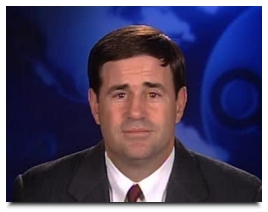 June 09, 2015 — [Gov. Arizona] Ducey concerned about Lake Mead levels but offers no solutions; defends cotton farmers TEMPE -- Gov. Doug Ducey offered praise Tuesday for Arizona's past water planning and saving measures and warned that Lake Mead's continually dropping water levels must be addressed, but made no specific proposals for how to deal with them. Ducey also stressed the need for federally financed conservation efforts and for augmenting the overtapped Colorado
River, but again offered no specifics. He also said that the state needs to be vigilant against efforts by the federal government to take away some of the state's water to help out California, which he said is far less prepared to deal with the drought than Arizona — Tucson.com
June 09, 2015 — [Gov. Arizona] Ducey concerned about Lake Mead levels but offers no solutions; defends cotton farmers TEMPE -- Gov. Doug Ducey offered praise Tuesday for Arizona's past water planning and saving measures and warned that Lake Mead's continually dropping water levels must be addressed, but made no specific proposals for how to deal with them. Ducey also stressed the need for federally financed conservation efforts and for augmenting the overtapped Colorado
River, but again offered no specifics. He also said that the state needs to be vigilant against efforts by the federal government to take away some of the state's water to help out California, which he said is far less prepared to deal with the drought than Arizona — Tucson.com
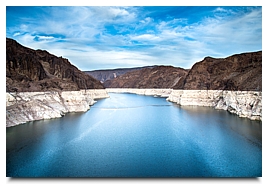 June 09, 2015 — Lake Mead About to Hit a Critical New Low as 15-Year Drought Continues in Southwest — Lake Mead, America’s largest U.S. reservoir when at capacity, is about to hit a critical new low. The reservoir near Las Vegas on the Colorado River has been in decline for decades because the reservoir and the larger Colorado River system has been over-allocated for many years. As of yesterday, the elevation of Lake Mead was 1,075.96. The reservoir is only days away from hitting 1,075 feet, according to the U.S. Bureau of Reclamation’s projections. That number is the threshold set in a 2007 agreement as part of the U.S. Department of Interior’s Colorado River Interim Guidelines, which calls for delivery cuts if water levels in Lake Mead drops below that level — ecowatch.com
June 09, 2015 — Lake Mead About to Hit a Critical New Low as 15-Year Drought Continues in Southwest — Lake Mead, America’s largest U.S. reservoir when at capacity, is about to hit a critical new low. The reservoir near Las Vegas on the Colorado River has been in decline for decades because the reservoir and the larger Colorado River system has been over-allocated for many years. As of yesterday, the elevation of Lake Mead was 1,075.96. The reservoir is only days away from hitting 1,075 feet, according to the U.S. Bureau of Reclamation’s projections. That number is the threshold set in a 2007 agreement as part of the U.S. Department of Interior’s Colorado River Interim Guidelines, which calls for delivery cuts if water levels in Lake Mead drops below that level — ecowatch.com
June 07, 2015 — California water losses 'huge,' new thinking required on drought, panel says — A panel of water experts mapped out the challenges California faces in meeting future demands for water at a time when water sources are under stress and supplies appear uncertain — LA Times
June 07, 2015 — SALTON SEA: Deep drought, troubled waters — Once-bustling marinas on Salton City’s shallow water in California’s largest lake a few years ago are bone-dry. Carcasses of oxygen-starved tilapia lie on desolate shores. Flocks of eared grebes and shoreline birds bob up and down to feast on marine life — pe.com
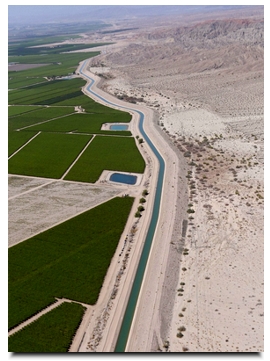 June 06, 2015 — Banking on the Colorado: Valley relies on fading river [THE DROUGHT-STRICKEN COLORADO RIVER IS FUELING GOLF COURSES AND GROWTH ACROSS THE COACHELLA VALLEY.] — Like the rest of the state, the Coachella Valley faces major water cutbacks in response to California's epic drought. But unlike most of the state, the valley has a water source that it's trying to use more of, not less of: the Colorado River. The desert has long relied on the Colorado for its survival, and that reliance is only growing. In an effort to protect the valley's over-pumped groundwater aquifer, local water managers are working to bring more Colorado River water to golf courses, new developments, housing tracts and other large water users — Sammy Roth, The Desert Sun
June 06, 2015 — Banking on the Colorado: Valley relies on fading river [THE DROUGHT-STRICKEN COLORADO RIVER IS FUELING GOLF COURSES AND GROWTH ACROSS THE COACHELLA VALLEY.] — Like the rest of the state, the Coachella Valley faces major water cutbacks in response to California's epic drought. But unlike most of the state, the valley has a water source that it's trying to use more of, not less of: the Colorado River. The desert has long relied on the Colorado for its survival, and that reliance is only growing. In an effort to protect the valley's over-pumped groundwater aquifer, local water managers are working to bring more Colorado River water to golf courses, new developments, housing tracts and other large water users — Sammy Roth, The Desert Sun
May / June 2015 —What You Need to Know About the Water Crisis in the West — Causes of, and potential solutions to the Water Crisis on the Colorado River — by Abrahm Lustgarten, David Sleight, Amanda Zamora and Lauren Kirchner, ProPublica, and John Grimwade, Special to ProPublica
 June 05, 2015 — Geologists: Artificial Grand Canyon floods are bringing back Colorado River sandbars
— Grand Canyon's sandbars are returning. After three straight years of experimental controlled floods unleashed to push sediments down the Colorado River, the U.S. Geological Survey released a report this week declaring the seasonal gushers a success. The sand deposits — ecological sanctuaries that also make great camping spots for rafting parties — disappeared after Glen Canyon Dam tamed the Colorado's floodwaters 52 years ago — sltrib.com
June 05, 2015 — Geologists: Artificial Grand Canyon floods are bringing back Colorado River sandbars
— Grand Canyon's sandbars are returning. After three straight years of experimental controlled floods unleashed to push sediments down the Colorado River, the U.S. Geological Survey released a report this week declaring the seasonal gushers a success. The sand deposits — ecological sanctuaries that also make great camping spots for rafting parties — disappeared after Glen Canyon Dam tamed the Colorado's floodwaters 52 years ago — sltrib.com
 June 05, 2015 — Why the Colorado River Basin Crisis is No Surprise — Perhaps you have heard how urgent it is for the upper basin states to take water from the Colorado River before those “Californians use it all up?” This us-versus-them attitude, as a justification to take more water from a finite system, will obviously not solve the regional water predicament. Later on, I will explain that scientists from California demonstrated early leadership to create equitable water solutions for everybody — John Weisheit is a co-founder of Living Rivers based in Moab, Utah.
June 05, 2015 — Why the Colorado River Basin Crisis is No Surprise — Perhaps you have heard how urgent it is for the upper basin states to take water from the Colorado River before those “Californians use it all up?” This us-versus-them attitude, as a justification to take more water from a finite system, will obviously not solve the regional water predicament. Later on, I will explain that scientists from California demonstrated early leadership to create equitable water solutions for everybody — John Weisheit is a co-founder of Living Rivers based in Moab, Utah.
 June 04, 2015 — The Long Odds On The Western Drought [8:24] — The odds on how long the current drought will last aren’t posted in the casinos on the Las Vegas Strip. But if they were, one choice would have to be: forever. Given this drought has the Southwest in a tight grip, the online investigative journalism magazine ProPublica has taken a deep look at water here. And, to put it mildly, they have so far left no one unscathed. — KNPR: Nevada
June 04, 2015 — The Long Odds On The Western Drought [8:24] — The odds on how long the current drought will last aren’t posted in the casinos on the Las Vegas Strip. But if they were, one choice would have to be: forever. Given this drought has the Southwest in a tight grip, the online investigative journalism magazine ProPublica has taken a deep look at water here. And, to put it mildly, they have so far left no one unscathed. — KNPR: Nevada
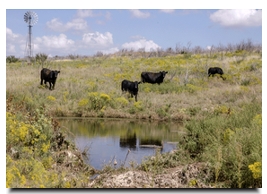 June 02, 2015 — Water issues intensify; will the livestock industry be left in the dust? — It has inspired bards, balladeers and artists of every ilk throughout the ages. It’s also inspired hard words, gunfire and more than a few court battles as the centerpiece in a fight that’s likely been going on for as long as humans have been around to fight with one another. “Water is essential for life,” says Tom McDonald. “Therefore, our existence and economy will ultimately depend on having an adequate supply of water.” — beefmagazine.com
June 02, 2015 — Water issues intensify; will the livestock industry be left in the dust? — It has inspired bards, balladeers and artists of every ilk throughout the ages. It’s also inspired hard words, gunfire and more than a few court battles as the centerpiece in a fight that’s likely been going on for as long as humans have been around to fight with one another. “Water is essential for life,” says Tom McDonald. “Therefore, our existence and economy will ultimately depend on having an adequate supply of water.” — beefmagazine.com
June 03, 2015 —Welcome to Fabulous Las Vegas — Vegas Water History [1905 – 2014] — ProPublica.org
 June 02, 2015 — The ‘Water Witch’ Pat Mulroy Preached Conservation While Backing Growth in Las Vegas — One afternoon last summer, Pat Mulroy stood in 106-degree heat at the broad concrete banister atop the Hoover Dam, the wall that holds back the mighty Colorado River, and with it the nation’s largest reserve of water. The reservoir is the brain stem of the system that helps sustain just about every person from here to San Diego. But as Mulroy looked out over the drought-beleaguered pool, then at 39 percent capacity, it appeared almost empty. “Scary,” Mulroy said. — ProPublica.org
June 02, 2015 — The ‘Water Witch’ Pat Mulroy Preached Conservation While Backing Growth in Las Vegas — One afternoon last summer, Pat Mulroy stood in 106-degree heat at the broad concrete banister atop the Hoover Dam, the wall that holds back the mighty Colorado River, and with it the nation’s largest reserve of water. The reservoir is the brain stem of the system that helps sustain just about every person from here to San Diego. But as Mulroy looked out over the drought-beleaguered pool, then at 39 percent capacity, it appeared almost empty. “Scary,” Mulroy said. — ProPublica.org
June 01, 2015 — Third straw at plunging Lake Mead nearly complete Six hundred feet down an elevator shaft near the shore of Lake Mead, the weight of Las Vegas’ future rests on a 19,000-pound plug at the mouth of a three-mile tunnel. The plug sits atop a domed cavern beneath the lake, holding back the pressure of millions of acre-feet of water. Later this summer, the tunnel will be flooded and a crane will pull out the plug, connecting the lake's third intake straw to nearby pumping stations and providing a new level of protection against a blistering drought that has sent Lake Mead's elevation to record low levels — Las Vegas Sun
May 29, 2015 — Time favors Las Vegas in effort to move rural Nevada water south — The Southern Nevada Water Authority’s vision of a pump and pipeline system from eastern rural counties to the thirsty Las Vegas Valley continues to be challenged in the courts on multiple fronts. It’s not as if the plan lacks controversy outside the courtroom. With a high-end cost estimated at up to $15 billion, it has been blasted by a wide variety of critics as wasteful, inefficient and an example of powerful Clark County bullying its rural neighbors. When Native American tribes and the Mormon Church are against you, consider your project controversial — John Smith, Las Vegas Review Journal
May 27, 2017 — How federal dollars are financing the water crisis in the West — STATE ROUTE 87, the thin band of pavement that approaches the mostly shuttered town of Coolidge, Ariz., cuts through some of the least hospitable land in the country. The valley of red and brown sand is interrupted occasionally by rock and saguaro cactus. It’s not unusual for summer temperatures to top 116 degrees. And there is almost no water; this part of Arizona receives less than nine inches of rainfall each year . . . an examination by ProPublica shows that the scarcity of water is as much a man-made crisis as a natural one, the result of decades of missteps and misapprehensions by governments and businesses as they have faced surging demand driven by a booming population — by Abrahm Lustgarten and Naveena Sadasivam, ProPublica
 May 23, 2015 — Supreme Court won’t wade into fight over Las Vegas water pipeline — For the second time this year, the Nevada Supreme Court has declined to dip its toe into a legal dispute over controversial plans to pipe groundwater to Las Vegas from across eastern Nevada. In an unpublished order issued Thursday, the court said it would not review several key technical questions raised by a 2013 ruling by Senior District Judge Robert Estes that effectively stripped the Southern Nevada Water Authority of water rights for its proposed pipeline. Estes ruled that the state’s chief water regulator failed to adequately support a decision two years earlier to allow the authority to sink its wells in four rural valleys in Lincoln and White Pine counties . . . Opponents of the pipeline said the Supreme Court decision is a victory and a vindication. Environmental attorney Simeon Herskovits, who has been fighting the groundwater project in court for years, called it “a devastating defeat for SNWA and the state engineer and their efforts to circumvent sound science.” — RJ.com [More Coverage 8NewsNow.com]
May 23, 2015 — Supreme Court won’t wade into fight over Las Vegas water pipeline — For the second time this year, the Nevada Supreme Court has declined to dip its toe into a legal dispute over controversial plans to pipe groundwater to Las Vegas from across eastern Nevada. In an unpublished order issued Thursday, the court said it would not review several key technical questions raised by a 2013 ruling by Senior District Judge Robert Estes that effectively stripped the Southern Nevada Water Authority of water rights for its proposed pipeline. Estes ruled that the state’s chief water regulator failed to adequately support a decision two years earlier to allow the authority to sink its wells in four rural valleys in Lincoln and White Pine counties . . . Opponents of the pipeline said the Supreme Court decision is a victory and a vindication. Environmental attorney Simeon Herskovits, who has been fighting the groundwater project in court for years, called it “a devastating defeat for SNWA and the state engineer and their efforts to circumvent sound science.” — RJ.com [More Coverage 8NewsNow.com]
May 22, 2015 — Nevada Supreme Court won't revisit Vegas water pipeline — RENO, Nev. The Nevada Supreme Court is sticking to an earlier decision that at least temporarily blocks water interests in Las Vegas from pumping new supplies from the high desert near the Nevada-Utah line. In brief orders Thursday, the high court refused to revisit the earlier pipeline ruling at the request of the Southern Nevada Water Authority and the Nevada state water engineer — AP
  Read GBWN's News Release [2 Page PDF] Read GBWN's News Release [2 Page PDF]
  Read the Court decisions Read the Court decisions
 May 21, 2015 — New Alarms Sounded About Lake Mead Water Levels — KNPR Radio Interview, Pat Mulroy, former head of the Southern Nevada Water Authority [8.36 min] . . . Mulroy told KNPR's State of Nevada that Nevada put an aggressive plan into place in 2003 in anticipation of an extended drought. "We've already conserved it. That was the plan going in that we not go into a crisis mode that we not have to go to Draconian conservation measures," Mulroy said. — KNPR May 21, 2015 — New Alarms Sounded About Lake Mead Water Levels — KNPR Radio Interview, Pat Mulroy, former head of the Southern Nevada Water Authority [8.36 min] . . . Mulroy told KNPR's State of Nevada that Nevada put an aggressive plan into place in 2003 in anticipation of an extended drought. "We've already conserved it. That was the plan going in that we not go into a crisis mode that we not have to go to Draconian conservation measures," Mulroy said. — KNPR
May 20, 2015 — Lake Mead’s low levels could trigger federal shortage by 2017 — Lake Mead is expected to shrink low enough by January 2017 to trigger a first-ever federal shortage declaration on the Colorado River, according to a bleak new projection from the U.S. Bureau of Reclamation. In its monthly forecast issued this week, the bureau predicts the reservoir east of Las Vegas could start 2017 as much as 15 feet below the shortage line of 1,075 feet above sea level. Only a month ago, forecasters expected the Colorado River to narrowly avoid a shortage in both 2016 and 2017 — RJ.com
 May 20, 2015 — Owens Valley ranchers and environmentalists brought together by drought — The drought has worked a miracle in the Owens Valley, as environmental activists and ranchers have buried decades of enmity to forge a plan to save ranch land — at the expense of hard-fought environmental protections — LA Times
May 20, 2015 — Owens Valley ranchers and environmentalists brought together by drought — The drought has worked a miracle in the Owens Valley, as environmental activists and ranchers have buried decades of enmity to forge a plan to save ranch land — at the expense of hard-fought environmental protections — LA Times
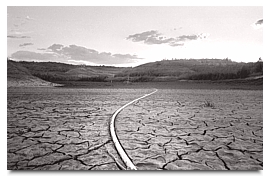 May 20, 2015 — Where the River Runs Dry — Our pilot, David Kunkel, asked me to retrieve his oxygen bottle from under my seat, and when I handed it to him he gripped the plastic breathing tube with his teeth and opened the valve. We had taken off from Boulder that morning, and were flying over Rocky Mountain National Park, about thirty miles to the northwest. We were in a Maule M-7, a single-engine “backcountry” plane, and Kunkel was navigating with the help of an iPad Mini, which was resting on his legs — The New Yorker
May 20, 2015 — Where the River Runs Dry — Our pilot, David Kunkel, asked me to retrieve his oxygen bottle from under my seat, and when I handed it to him he gripped the plastic breathing tube with his teeth and opened the valve. We had taken off from Boulder that morning, and were flying over Rocky Mountain National Park, about thirty miles to the northwest. We were in a Maule M-7, a single-engine “backcountry” plane, and Kunkel was navigating with the help of an iPad Mini, which was resting on his legs — The New Yorker
May 19, 2015 — DWP takes first step toward possible rate increases — TheLos Angeles Department of Water and Power took a first step Tuesday toward possible rate increases as it tries to address aging infrastructure that has resulted in spectacular water pipe breaks and other problems. The Board of Water and Power Commissioners ordered up a plan examining how the nation's largest municipal utility can generate millions of dollars in new revenue — LA Times
May 19, 2015 —Clark County population hits record as water concerns persist — The population in Clark County hit the record-high 2 million mark last year, according to an annual report released Tuesday about the region's economy. During the 35th annual Las Vegas Perspective, professionals from construction, finance and tourism gathered at the Four Seasons to hear the good news and the bad news about Sin City's economy. According to the report, the population of Clark County grew to 2.1 million people in 2014 - up 2 percent from the previous year. The boom in growth comes with its own challenges, said Jeremy Aguero, a principal analyst at Applied Analysis, which assembles the report. "I think some of our weaknesses have got to be the fact that our education system is underperforming, which is making us less competitive in technology," Aguero said. Aguero said there are also concerns about the water resources in the region — Fox5Vegas.com
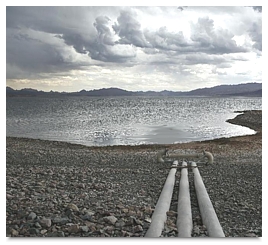 May 19, 2015 — Feds project Lake Mead below drought trigger point in 2017 — LAS VEGAS — Federal water managers released a report Monday projecting that Lake Mead's water levels will fall below a point in January 2017 that would force supply cuts to Arizona and Nevada. The effects could be serious.
May 19, 2015 — Feds project Lake Mead below drought trigger point in 2017 — LAS VEGAS — Federal water managers released a report Monday projecting that Lake Mead's water levels will fall below a point in January 2017 that would force supply cuts to Arizona and Nevada. The effects could be serious.
Arizona's allocation of Colorado River water could be cut 11.4 percent, or by an amount normally used by more than 600,000 homes. Nevada's share could be reduced 4.3 percent. Think 26,000 homes — AP
 May 18, 2015 — [Tucson] Colorado River report poses tough questions about future — It’s not clear how much more water people in Tucson and other cities can conserve to bail out the drought-stricken Colorado River. At some point, we’ll hit a wall at which more conservation won’t be possible.
May 18, 2015 — [Tucson] Colorado River report poses tough questions about future — It’s not clear how much more water people in Tucson and other cities can conserve to bail out the drought-stricken Colorado River. At some point, we’ll hit a wall at which more conservation won’t be possible.
It will be difficult, if not impossible, for the region to limit the growth that threatens to outrun the water savings achieved by conservation — Tucson.com
May 17, 2015 —Disappearing Lake Powell underlines drought crisis facing Colorado river — As water levels plummet to 45% in America’s second-largest reservoir, new islands appear – and fears grow for a waterway that serves 40 million people — The Guardian.com
May 16, 2015 — Slideshow — Water level in lake mead largest reservoir in the us drops 150 feet in 14 years — Yahoe News
May 14, 2015 — L.A. getting no Owens Valley runoff for first time since 1913 — For the first time since 1913 – when Department of Water and Power chief architect William Mulholland opened the waterway with the words, "There it is. Take it!" – the 233–mile Los Angeles Aqueduct has stopped carrying Owens Valley runoff to Los Angeles. As severe drought continues to grip California, the DWP confirmed Thursday that it had dammed the aqueduct at Owens Lake in order to conserve meager Eastern Sierra snow runoff — LA Times
May 14, 2015 — Lawsuit: water district fired workers who were too old, knew too much — For the second time this year, the valley’s largest water utility is being sued by former employees who claim they were forced off the job in part to cover up mistakes and wrongdoing that cost ratepayers millions of dollars. The latest civil suit, filed April 30 in Clark County District Court, involves 16 people who accuse the Las Vegas Valley Water District of retaliation, discrimination and breach of contract among other claims — RJ.com
May 14, 2015 — Colorado's rain isn't helping Southwest reservoirs — AP
May 14, 2015 — California at Low Water – a Photo Gallery — kqed.org
May 12, 2015 — How California’s New Environmental Regulations On Desalination Affect Carlsbad’s Plant — As the Carlsbad desalination plant gets ready to go online later this year, there are 15 proposed desalination plants currently being evaluated by California water officials, according to media reports Kpbs.org
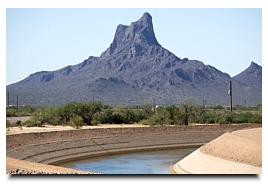 May 12, 2015 — Report: No 'silver bullet' for Colorado River's problems — While cities and farms across the Colorado River basin are likely to conserve much more water over the coming decades, there's no “silver bullet” solution for the river's major water problems, according to a new federal report. A great deal of progress has already been made across the basin in making urban and agricultural water use more efficient in recent decades, said the report, released Tuesday and produced by working groups organized by the U.S. Bureau of Reclamation — Arizona Daily Star
May 12, 2015 — Report: No 'silver bullet' for Colorado River's problems — While cities and farms across the Colorado River basin are likely to conserve much more water over the coming decades, there's no “silver bullet” solution for the river's major water problems, according to a new federal report. A great deal of progress has already been made across the basin in making urban and agricultural water use more efficient in recent decades, said the report, released Tuesday and produced by working groups organized by the U.S. Bureau of Reclamation — Arizona Daily Star
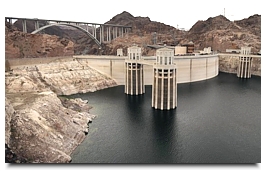 May 11, 2015 — Colorado River water shortage looms [If supply cuts occur, Southern California would lose out] — California’s drought emergency woes have worsened, with a shortage on the Colorado River next year becoming increasingly likely. Odds of a shortage rose from 33 percent to 50 percent from April 1 to May 1, Metropolitan Water District, Southern California’s largest water wholesaler, said Monday. Also Monday, a Metropolitan committee also unsuccessfully considered a proposal to spend an extra $150 million on water conservation projects, such as paying to replace grass with low water-use landscaping — utSanDiego.com
May 11, 2015 — Colorado River water shortage looms [If supply cuts occur, Southern California would lose out] — California’s drought emergency woes have worsened, with a shortage on the Colorado River next year becoming increasingly likely. Odds of a shortage rose from 33 percent to 50 percent from April 1 to May 1, Metropolitan Water District, Southern California’s largest water wholesaler, said Monday. Also Monday, a Metropolitan committee also unsuccessfully considered a proposal to spend an extra $150 million on water conservation projects, such as paying to replace grass with low water-use landscaping — utSanDiego.com
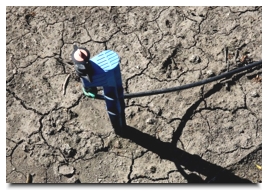 May 10, 2015 —
Arizona prepares to restrict water use for farming in 2016
— With Lake Mead at record lows, Arizona is preparing to implement water rationing plans that have been in place in since the 1990s — the largest cuts will impact farming in the state. According to Slate magazine, Lake Mead was at 1,080 feet above sea level last week, which marks the first time the lake has been that low “since the construction of the Hoover Dam in the 1930s.” — breitbart.com
May 10, 2015 —
Arizona prepares to restrict water use for farming in 2016
— With Lake Mead at record lows, Arizona is preparing to implement water rationing plans that have been in place in since the 1990s — the largest cuts will impact farming in the state. According to Slate magazine, Lake Mead was at 1,080 feet above sea level last week, which marks the first time the lake has been that low “since the construction of the Hoover Dam in the 1930s.” — breitbart.com
May 10, 2015 — Drought Transcends State Lines as U.S. West Turns Ever-More Arid The record drought plaguing California isn’t limited by lines on a map. Arid conditions caused by dwindling rainfall and snowpack are stretching across the West — Bloomberg
May 08, 2015 — [Editorial] Utah lacks good numbers on water needs — For years, conservation groups and good government activists have questioned the numbers used by the Utah Division of Natural Resources and others to project the need for some $33 billion in environmentally disruptive projects to meet the water demands of a rapidly growing state population — Sltrib.com
May 07, 2015 — Israel to California: Here's how to save water — YATIR FOREST, Israel - As Californians struggle with an ever-worsening water shortage caused by a historic drought, they might look east for a solution - to the Middle East — CentralOhio.com
May 06, 2015 — Water Pricing in Two Thirsty Cities: In One, Guzzlers Pay More, and Use Less —FRESNO, Calif. — When residents of this parched California city opened their water bills for April, they got what Mayor Ashley Swearengin called “a shock to the system.” The city had imposed a long-delayed, modest rate increase — less than the cost of one medium latte from Starbucks for the typical household, and still leaving the price of water in Fresno among the lowest across the entire Western United States. But it was more than enough to risk what the mayor bluntly admits could be political suicide — NyTimes.com
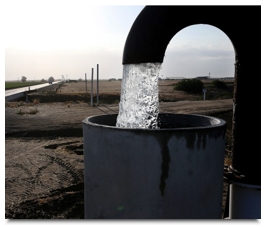 May 05, 2015 — How Satellites Can Monitor California’s Underground Water — CALIFORNIA IS RUNNING on groundwater right now. As the state has cut down on surface water deliveries from rivers and reservoirs, farmers and municipal water suppliers have reacted by sucking more and more out of Madre Earth. The state’s land, in response, is sinking lower and lower, day by day, year by year In times of crisis, turning to groundwater is understandable (it may even be unavoidable).
May 05, 2015 — How Satellites Can Monitor California’s Underground Water — CALIFORNIA IS RUNNING on groundwater right now. As the state has cut down on surface water deliveries from rivers and reservoirs, farmers and municipal water suppliers have reacted by sucking more and more out of Madre Earth. The state’s land, in response, is sinking lower and lower, day by day, year by year In times of crisis, turning to groundwater is understandable (it may even be unavoidable).
But—as it stares down its inevitably dessicated future—California is finally waking up to the need to monitor and protect these reserves. To do that, the state’s Department of Water Resources is turning to new techniques using satellite data which, by measuring changes in the ground above, can keep an eye on water levels below. Essentially, if the Golden State is going to weather this disaster, it will need some help from up high — Wired.com
May 05, 2015 — [Utah] Audit reveals flawed projections on Utah's water needs — SALT LAKE CITY — A legislative audit released Tuesday concludes state water managers have no real idea how much water is being used across Utah so the projection that developed supplies will be exhausted by 2040 is not reliable — DesertNews.com [Related Story, HCN]
May 04, 2015 — Water Pipeline Triggers Debate About Utah's Future — In a parched corner of the nation's second driest state, the Virgin River delivers life-giving water to wildlife, farms and increasing numbers of people. Ron Thompson sees a future when four times as many people could be living here in St. George, and they’ll need more water than the Virgin can provide. That’s why he wants the Lake Powell Pipeline — Kuer.org 
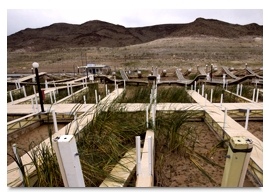 May 04, 2015 — Drought’s Extremes Can Be Measured at Record-Low Lake Mead — LAKE MEAD NATIONAL RECREATION AREA, Nev. — Gail Kaiser has spent much of her life here on Lake Mead, with its crystal blue water pouring into canyons and splintering off like blood vessels into coves and bays, forming the vast reservoir that stretches into two states. She was just a child when, in 1957, her father took over the marina that has stayed in her family’s hands ever since. The lake, which is part of the Colorado River system and feeds into the Hoover Dam, was designed to fluctuate like a giant bathtub — NyTimes.com
May 04, 2015 — Drought’s Extremes Can Be Measured at Record-Low Lake Mead — LAKE MEAD NATIONAL RECREATION AREA, Nev. — Gail Kaiser has spent much of her life here on Lake Mead, with its crystal blue water pouring into canyons and splintering off like blood vessels into coves and bays, forming the vast reservoir that stretches into two states. She was just a child when, in 1957, her father took over the marina that has stayed in her family’s hands ever since. The lake, which is part of the Colorado River system and feeds into the Hoover Dam, was designed to fluctuate like a giant bathtub — NyTimes.com
 May 01, 2015 — California snowpack survey canceled: 'Drought is severe' — State water officials had planned to make the trek back to the Sierra Nevada to conduct their snowpack measurement Friday. But Thursday they announced they wouldn’t bother. For the second consecutive month, there won’t be any snow to measure. “This is just another piece of information in a series of increasingly dismal findings,” said Department of Water Resources spokesman Doug Carlson. “It nails down that the drought is severe – maybe as severe as any in our history.” — LA Times
May 01, 2015 — California snowpack survey canceled: 'Drought is severe' — State water officials had planned to make the trek back to the Sierra Nevada to conduct their snowpack measurement Friday. But Thursday they announced they wouldn’t bother. For the second consecutive month, there won’t be any snow to measure. “This is just another piece of information in a series of increasingly dismal findings,” said Department of Water Resources spokesman Doug Carlson. “It nails down that the drought is severe – maybe as severe as any in our history.” — LA Times
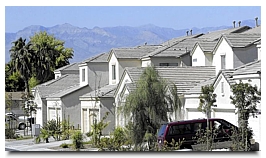 May 01, 2015 — Amid drought, the West is no place for a lawn, as Nevada has learned — When Gov. Jerry Brown ordered that California rip up 50 million square feet of lawns to conserve water amid the West's deadening drought, the Golden State gasped. Meanwhile, the Silver State [Nevada] yawned. Desert denizens have already been there and done that — since 1999, in fact — LA Times
May 01, 2015 — Amid drought, the West is no place for a lawn, as Nevada has learned — When Gov. Jerry Brown ordered that California rip up 50 million square feet of lawns to conserve water amid the West's deadening drought, the Golden State gasped. Meanwhile, the Silver State [Nevada] yawned. Desert denizens have already been there and done that — since 1999, in fact — LA Times
April 30, 2015 — California’s wildfire season now runs year-round — In California, the first week of May has come to represent the beginning of wildfire season, with events to raise awareness of the dangers to come. This year, however, is different. The ongoing drought, the continued mismanagement of forestlands and the nonsensical funding formula for fire prevention have led to a year-round wildfire season in California — SacBee.com
April 30, 2015 — Dead in the water, State lost years while drought worsened — Cloud seeding in a desert state may seem like a no-brainer. But six years ago, the Nevada Legislature effectively shut down the state’s program. Even at the time, it seemed shortsighted. When local officials learned of the decision, the Desert Research Institute—a scientific arm of the state—was already dismantling Sierra monitoring stations NewsReview.com
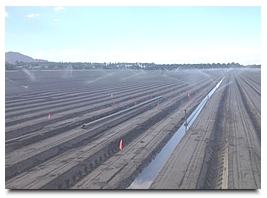 April 29, 2015 —
Report: California needs more farm water data — The Pacific Institute has released a new report summing up what’s known about the amounts of water used for agriculture in California, and one of the takeaways is that the state lacks comprehensive and up-to-date information — DesertSun.com
April 29, 2015 —
Report: California needs more farm water data — The Pacific Institute has released a new report summing up what’s known about the amounts of water used for agriculture in California, and one of the takeaways is that the state lacks comprehensive and up-to-date information — DesertSun.com
 April 29, 2015 —
Lake Mead water level falls to a landmark low, and is likely to get worse — For Western states enduring a debilitating drought, the news is bone-dry bad: Anemic Lake Mead has hit a historic low level. . . "The death of Lake Mead should be a wake-up call to people across the West that we need to boldly address this drought," said Howard Watts, a spokesman for the Great Basin Water Network, a nonprofit group composed of environmentalists, ranchers and Native Americans that seeks to preserve the health of the Colorado River system. "We've been slow to act, slow to react. Nobody knows when this drought is going to end. We need to become far more aggressive in areas of conservation to protect lake levels from falling even lower." — LA Times
April 29, 2015 —
Lake Mead water level falls to a landmark low, and is likely to get worse — For Western states enduring a debilitating drought, the news is bone-dry bad: Anemic Lake Mead has hit a historic low level. . . "The death of Lake Mead should be a wake-up call to people across the West that we need to boldly address this drought," said Howard Watts, a spokesman for the Great Basin Water Network, a nonprofit group composed of environmentalists, ranchers and Native Americans that seeks to preserve the health of the Colorado River system. "We've been slow to act, slow to react. Nobody knows when this drought is going to end. We need to become far more aggressive in areas of conservation to protect lake levels from falling even lower." — LA Times
April 29, 2015 — Pipeline would provide new water for North Valleys — Reno's primary water provider is poised to tap a new source of water that has sat unused but largely ready to go for nearly a decade. The $17.8 million project planned by the Truckee Meadows Water Authority would allow the utility to draw groundwater from far north of Reno and serve homes throughout the North Valleys area — RGJ.com
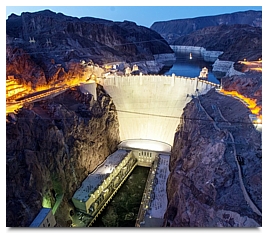 April 27, 2015 — Western drought steals clean energy along with fresh water at power plants — INSIDE HOOVER DAM — The floor rumbled under Mark Cook. His legs vibrated as he stood in a tunnel tucked into the thick base of Hoover Dam, 430 feet below the tourists looking out over Lake Mead. Beneath him, water roared through steel pipes 13 feet tall. Nearby, heavy turbines hummed with mechanical intensity. “We’re moving some good water today,” Cook, the dam manager, said proudly. Moving water means making electricity. But the drought is making that harder to do — WashingtonPost.com
April 27, 2015 — Western drought steals clean energy along with fresh water at power plants — INSIDE HOOVER DAM — The floor rumbled under Mark Cook. His legs vibrated as he stood in a tunnel tucked into the thick base of Hoover Dam, 430 feet below the tourists looking out over Lake Mead. Beneath him, water roared through steel pipes 13 feet tall. Nearby, heavy turbines hummed with mechanical intensity. “We’re moving some good water today,” Cook, the dam manager, said proudly. Moving water means making electricity. But the drought is making that harder to do — WashingtonPost.com
April 27, 2015 — Do We Have Enough Water? —The Sierra Nevada is experiencing the most dismal snowpack in a century, causing many people to worry about the water supply — 4:48 min. To address their concerns, Reno Public Radio’s Anh Gray sits down with John Erwin who heads up water planning at the Truckee Meadows Water Authority — KUNR
 April 27, 2015 — Letter to the editor — Water grab — The in-depth profile of Pat Mulroy made the mistake many others have made in evaluating her, abandoning balance and working to explain away the hypocrisies of her tenure as Las Vegas’ water boss (“Unite and Conquer,” HCN, 4/13/15) — High Country News
April 27, 2015 — Letter to the editor — Water grab — The in-depth profile of Pat Mulroy made the mistake many others have made in evaluating her, abandoning balance and working to explain away the hypocrisies of her tenure as Las Vegas’ water boss (“Unite and Conquer,” HCN, 4/13/15) — High Country News
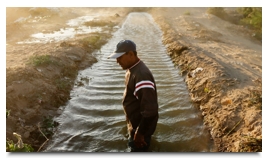 April 27, 2015 — US-Mexico water pact brings life back to Colorado River’s parched delta — LOS ALGODONES, Mexico — Mexican fieldworker Mario Mendoza, 47, had not seen the waters of the Colorado River flow through the desert of northwestern Mexico since he was a child. But after the floodgates on a dam near Los Algodones, a town on the Arizona-Mexico border, opened last year, he watched in awe as the dusty channel began to fill with water and start to flow once again toward the Sea of Cortez — America.Aljazeera.com
April 27, 2015 — US-Mexico water pact brings life back to Colorado River’s parched delta — LOS ALGODONES, Mexico — Mexican fieldworker Mario Mendoza, 47, had not seen the waters of the Colorado River flow through the desert of northwestern Mexico since he was a child. But after the floodgates on a dam near Los Algodones, a town on the Arizona-Mexico border, opened last year, he watched in awe as the dusty channel began to fill with water and start to flow once again toward the Sea of Cortez — America.Aljazeera.com
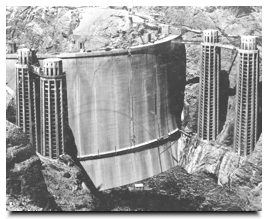 April 27, 2015 — From Bad to Worse: Lake Mead Expected to Hit New Historic Low — Sometime overnight Sunday, Lake Mead, the vast reservoir behind Hoover Dam outside Las Vegas, was projected to have hit a new historic low as drought continues to throttle the Colorado River system. When we reported here on Mead last August, the lake had hit a modern-day low of 1,080.19 feet elevation above sea level. On Friday morning, the water level was at 1,080.47 feet, with Hoover Dam releasing water downstream in the neighborhood of 18,000 cubic feet per second. So the new record could have been set while we slept. You can see for yourself here — Inewsnetwork.org
April 27, 2015 — From Bad to Worse: Lake Mead Expected to Hit New Historic Low — Sometime overnight Sunday, Lake Mead, the vast reservoir behind Hoover Dam outside Las Vegas, was projected to have hit a new historic low as drought continues to throttle the Colorado River system. When we reported here on Mead last August, the lake had hit a modern-day low of 1,080.19 feet elevation above sea level. On Friday morning, the water level was at 1,080.47 feet, with Hoover Dam releasing water downstream in the neighborhood of 18,000 cubic feet per second. So the new record could have been set while we slept. You can see for yourself here — Inewsnetwork.org
April 26, 2015 —
California's Doomsday Water Cycle — In California and around the world, water supply and carbon-based energy production are locked in a destructive feedback cycle. Fossil fuel extraction and combustion consume water -- lots of it. Obtaining and delivering water, in turn, requires energy -- lots of it. Too little of one yield shortages of the other. Climate change -- the result of burning too much fossil fuel while destroying forests and soils -- accelerates this cycle, disrupting the equilibrium between climate and water that enables civilization By Carl Pope – bloombergview.com
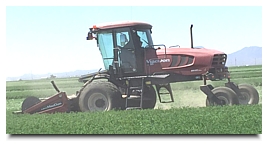 April 26, 2015 — Water: Conserving the Colorado River's Liquid Gold — WATER LEVELS AT RECORD LOW: Over the past 15 years, the water level at Lake Mead has dropped nearly 140 feet, revealing a white, mineral bath ring that dwarfs boaters as they navigate the narrowing waterways. When this article posted, the water level was at 1,801 acre-feet. Another six feet and it will trigger an automatic shortage declaration. This summer's triple digit temperatures are threatening to siphon off the remaining margin of water. If it happens, this August, the Federal Bureau of Reclamation will announce cutbacks to the 7.5 million acre-feet of water normally delivered each year to the Colorado River Lower Basin, which includes California, Nevada, and Arizona — Ktar.com
April 26, 2015 — Water: Conserving the Colorado River's Liquid Gold — WATER LEVELS AT RECORD LOW: Over the past 15 years, the water level at Lake Mead has dropped nearly 140 feet, revealing a white, mineral bath ring that dwarfs boaters as they navigate the narrowing waterways. When this article posted, the water level was at 1,801 acre-feet. Another six feet and it will trigger an automatic shortage declaration. This summer's triple digit temperatures are threatening to siphon off the remaining margin of water. If it happens, this August, the Federal Bureau of Reclamation will announce cutbacks to the 7.5 million acre-feet of water normally delivered each year to the Colorado River Lower Basin, which includes California, Nevada, and Arizona — Ktar.com
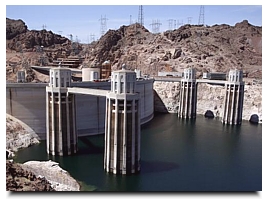 April 23, 2015 — Savage drought will drive Lake Mead to record low on Sunday — Sunday’s forecast for Lake Mead calls for breezy conditions, with a high in the low 80s and a water level as low as it has been in 78 years. The reservoir east of Las Vegas is expected to reach a new record low this weekend and continue downward another 7 feet through June, as the drought-stricken Colorado River withers from its 12th dry year since 2000 — RJ.com
April 23, 2015 — Savage drought will drive Lake Mead to record low on Sunday — Sunday’s forecast for Lake Mead calls for breezy conditions, with a high in the low 80s and a water level as low as it has been in 78 years. The reservoir east of Las Vegas is expected to reach a new record low this weekend and continue downward another 7 feet through June, as the drought-stricken Colorado River withers from its 12th dry year since 2000 — RJ.com
April 23, 2013 — Officials: Colorado River shortage not 'a crisis' for Az in near term — Arizona’s communities, industries, mines and Native American tribes aren’t likely to be affected during the next five years if federal officials declare a shortage on the Colorado River, officials said Wednesday. While Central Arizona Project rates may rise, deliveries for groundwater replenishment would be eliminated and central Arizona agriculture would take a hit, leaders of a workshop held at the Arizona Department of Water Resources said the state is ready for a shortage on the Colorado — Tucsonsentinel.com
April 23, 2015 — Lessons From Australia’s 17-Year Drought
April 22, 2015 — Colorado River runoff forecast gets a bit bleaker — The latest federal forecast for runoff in the Colorado River Basin is a bit gloomier than the one of just two weeks ago. It predicts April-July runoff into Lake Powell will be 47 percent of normal, compared to 52 percent of normal that was expected in early April. Dry weather in April accounts for much of the decline in forecasted runoff, said Brenda Alcorn, a senior hydrologist for NOAA's Colorado River Basin Forecast Center. NOAA is short for the National Oceanic and Atmospheric Administration — Tucson.com
April 22, 2015 — California isn’t the only state with water problems — Western states have been dealing with water problems for a while, but they won't be alone for long. As drought, flooding, and climate change restrict America's water supply, demands from population growth and energy production look set to increase, according to a report from the U.S. Government Accountability Office — Yahoo.com
April 21, 2015 — Lake Mead hits near-record low water level — 8NewsNow.com
April 21, 2015 — Jerry Brown calls tiered-water ruling ‘a straitjacket’ for conservation efforts An appellate court Monday struck down a Southern California city’s method of charging water users based on a tiered-rate system, a potential setback to municipalities across a parched state laboring to curtail water consumption under Gov. Jerry Brown’s recent order — SacBee.com
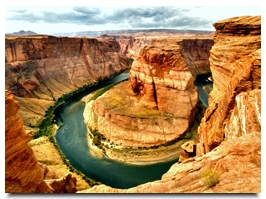 April 21, 2015 — 4 Ways to Beat the California Drought and Save the Colorado River — The epic drought in California is beatable and we can save the Colorado River. All of Southern California—including the massive farm fields in Imperial County, the grapes and golf courses in the Coachella Valley and Palm Springs, and every person from Los Angeles to San Diego—gets most of its water from the Colorado River. The very same drought that has hammered southern California is almost as bad across the entire Southwest U.S.—including in the mountains of Utah, Wyoming and Colorado which are the source of water for the Colorado River that feeds Southern California — Gary Wockner
April 21, 2015 — 4 Ways to Beat the California Drought and Save the Colorado River — The epic drought in California is beatable and we can save the Colorado River. All of Southern California—including the massive farm fields in Imperial County, the grapes and golf courses in the Coachella Valley and Palm Springs, and every person from Los Angeles to San Diego—gets most of its water from the Colorado River. The very same drought that has hammered southern California is almost as bad across the entire Southwest U.S.—including in the mountains of Utah, Wyoming and Colorado which are the source of water for the Colorado River that feeds Southern California — Gary Wockner
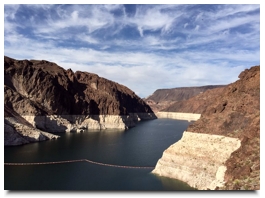 April 17, 2015 — As Lake Mead Levels Drop, The West Braces For Bigger Drought Impact — The historic four-year drought in California has been grabbing the headlines lately, but there's a much bigger problem facing the West: the now 14-year drought gripping the Colorado River basin. One of the most stunning places to see its impact is at the nation's largest reservoir, Lake Mead, near Las Vegas. At about 40 percent of capacity, it's the lowest it's been since it was built in the 1930s — NPR [
April 17, 2015 — As Lake Mead Levels Drop, The West Braces For Bigger Drought Impact — The historic four-year drought in California has been grabbing the headlines lately, but there's a much bigger problem facing the West: the now 14-year drought gripping the Colorado River basin. One of the most stunning places to see its impact is at the nation's largest reservoir, Lake Mead, near Las Vegas. At about 40 percent of capacity, it's the lowest it's been since it was built in the 1930s — NPR [ 4 min 34 sec] 4 min 34 sec]
April 16, 2015 — Coping With Western Drought With No End In Sight — In the desert, water is more valuable than gold. Drought has been gripping Nevada and the region for years. In California, Governor Jerry Brown recently demanded a 25 percent cut in residential use after the drought reached extreme proportions there. Pat Mulroy formerly of the Southern Nevada Water Authority and currently the senior fellow for climate adaptation and environmental policy at UNLV’s Brookings Mountain West told KNPR’s State of Nevada that Gov. Brown had little choice.“What he did was his only option out there right now,” Mulroy said. Jeffrey Kightlinger agrees. He is the general manager of the Metropolitan Water District of Southern Nevada — KNPR - Nevada 
April 15, 2015 — Redistribute California's Water? Not Without A Fight — The state of California is asking a basic question right now that people often fight over: What's a fair way to divide up something that's scarce and valuable? That "something," in this case, is water — NPR [ 4 min 17 sec] 4 min 17 sec]
April 15, 2015 — ‘Deniers’ cynically take millions from far-right to smear top climate scientists — Opinon: The capital’s right-wing lobbying legions are far off-base charging that a handful of congressional progressives are conducting McCarthy-style vendettas against climate-change deniers — oleantimesherald.com
 April 14, 2015 — Salt Lake City issues water-shortage advisory — Salt Lake City took the first official step Monday to notify its residents of possible water shortages this summer. Mayor Ralph Becker issued a "stage one advisory," the first of five steps in the city's contingency plan for dealing with drought . . . Steve Erickson, the Utah Audubon Council's legislative advocate, called the city's advisory "an appropriate move to get people's attention. It's been a grim winter. We're likely to see this get worse so people need to start thinking about how they can conserve water — not just in Salt Lake City but around the state — Salt Lake Tribune
April 14, 2015 — Salt Lake City issues water-shortage advisory — Salt Lake City took the first official step Monday to notify its residents of possible water shortages this summer. Mayor Ralph Becker issued a "stage one advisory," the first of five steps in the city's contingency plan for dealing with drought . . . Steve Erickson, the Utah Audubon Council's legislative advocate, called the city's advisory "an appropriate move to get people's attention. It's been a grim winter. We're likely to see this get worse so people need to start thinking about how they can conserve water — not just in Salt Lake City but around the state — Salt Lake Tribune
April 14, 2015 — California: Higher water rates on tap as utilities cover losses from drought Planning to save water this year to help with the drought? Don’t expect to save money. Water departments across California, including dozens in the Bay Area, are now looking to raise rates — in many cases by double digits — to shore up revenues as customers use less water during dry times and water sales plummet — SFGate.com
April 14, 2015 — Press Release: Snowpack melts early across the West — WASHINGTON: West-wide snowpack is“ch is too bad, because there are some obvious (and not-so-obvious) science-based studies that touch on the unfolding disaster – with implications for what the future holds for the most populous state in the United States — usnews.com
April 13, 2015 — Nevada drought: What's being done? — Nevada Appeal
April 13, 2015 — In California, a Wet Era May Be Ending — When Gov. Jerry Brown of California imposed mandatory cutbacks in water use earlier this month in response to a severe drought, he warned that the state was facing an uncertain future. “This is the new normal,” he said, “and we’ll have to learn to cope with it.” The drought, now in its fourth year, is by many measures the worst since the state began keeping records of temperature and precipitation in the 1800s. And with a population now close to 39 million and a thirsty, $50 billion agricultural industry, California has been affected more by this drought than by any previous one — NyTimes.com
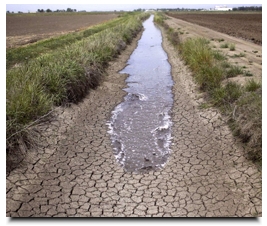 April 13, 2015 — One chart sums up the real problem in the California drought— and it isn't almonds — You might've heard that if there's one food you shouldn't be buying in the middle of California's drought, it's almonds.
April 13, 2015 — One chart sums up the real problem in the California drought— and it isn't almonds — You might've heard that if there's one food you shouldn't be buying in the middle of California's drought, it's almonds.
Compared with many other nuts and veggies, almonds seem particularly wasteful, requiring a whole gallon of water per nut. But what about the foods we eat that aren't nuts or vegetables? I'm talking about meat — BusinessInsider.com
April 12, 2015 — Megascale Desalination: The world’s largest and cheapest reverse-osmosis desalination plant is up and running in Israel. — On a Mediterranean beach 10 miles south of Tel Aviv, Israel, a vast new industrial facility hums around the clock. It is the world’s largest modern seawater desalination plant, providing 20 percent of the water consumed by the country’s households. Built for the Israeli government by Israel Desalination Enterprises, or IDE Technologies, at a cost of around $500 million, it uses a conventional desalination technology called reverse osmosis (RO). Thanks to a series of engineering and materials advances, however, it produces clean water from the sea cheaply and at a scale never before achieved — Technologyreview.com
April 12, 2015 — OPINION: Guest Commentary: Heed California water woes, Colorado — The Denver Post
April 10, 2015 — This is how we avoid climate catastrophe: The simple –yet radical – steps needed to solve California’s water crisis — California’s worsening drought is an environmental disaster, the result of multiple years of below-average rainfall and above-average heat and very likely amplified, experts say, by man-made climate change. But not everyone is suffering the unprecedented deficit equally. Some, you might even go so far as to say, are winning — Salon.com
April 09, 2015 — Crap Detecting and California Water — Aquadoc.typepad.com
April 08, 2015 — Sandoval creates drought panel, says Nevada much better off than California — WASHOE LAKE STATE PARK — Gov. Brian Sandoval stood on the dusty shore of a shrinking lake bed Wednesday to sign an executive order creating a forum to study Nevada’s lingering drought and recommend state policies. Sandoval, joined by state and local government water officials, said the Nevada Drought Forum, comprising water managers and climate experts from around the state, will craft a blueprint on best practices for water use and conservation — RJ.com
Read the Governor's Executive Order
 April 05, 2015 — Beneath California Crops, Groundwater Crisis Grows — Even as the worst drought in decades ravages California, and its cities face mandatory cuts in water use, millions of pounds of thirsty crops like oranges, tomatoes and almonds continue to stream out of the state and onto the nation’s grocery shelves. But the way that California farmers have pulled off that feat is a case study in the unwise use of natural resources, many experts say. Farmers are drilling wells at a feverish pace and pumping billions of gallons of water from the ground, depleting a resource that was critically endangered even before the drought, now in its fourth year, began — NyTimes.com April 05, 2015 — Beneath California Crops, Groundwater Crisis Grows — Even as the worst drought in decades ravages California, and its cities face mandatory cuts in water use, millions of pounds of thirsty crops like oranges, tomatoes and almonds continue to stream out of the state and onto the nation’s grocery shelves. But the way that California farmers have pulled off that feat is a case study in the unwise use of natural resources, many experts say. Farmers are drilling wells at a feverish pace and pumping billions of gallons of water from the ground, depleting a resource that was critically endangered even before the drought, now in its fourth year, began — NyTimes.com
April 05, 2015 — Will Turning Seawater Into Drinking Water Help Drought-Hit California? — Last week, Governor Jerry Brown made water conservation mandatory in the drought-stricken state of California. "As Californians, we have to pull together and save water in every way we can," he said. But if the four-year drought continues, conservation alone — at least what's required by the governor's plan — won't fix the problem — NPR
April 05, 2015 — Californians with century-old water rights face restrictions — Thousands of California farms and other businesses have rights to divert water for their needs, including irrigation and for hydroelectric dams. But if dry conditions continue through summer, they will likely face restrictions on taking water — AP
 April 05, 2015 — California Drought Tests History of Endless Growth — LOS ANGELES: For more than a century, California has been the state where people flocked for a better life — 164,000 square miles of mountains, farmland and coastline, shimmering with ambition and dreams, money and beauty.
April 05, 2015 — California Drought Tests History of Endless Growth — LOS ANGELES: For more than a century, California has been the state where people flocked for a better life — 164,000 square miles of mountains, farmland and coastline, shimmering with ambition and dreams, money and beauty.
It was the cutting-edge symbol of possibility: Hollywood, Silicon Valley, aerospace, agriculture and vineyards. But now a punishing drought – and the unprecedented measures the state announced last week to compel people to reduce water consumption – is forcing a reconsideration of whether the aspiration of untrammeled growth that has for so long been this state’s driving engine has run against the limits of nature — NyTimes.com
April 01, 2015 — California water mandates won’t affect southern Nevada rules — In the wake of a landmark California water conservation mandate announced Wednesday, Southern Nevada officials said water policies here will not be changed.
California Gov. Jerry Brown, a four-term Democrat, called for a mandatory, statewide 25 percent reduction in water usage for cities and towns. The mandate is the first of its kind in the Golden State and is expected to save nearly 489 billion gallons of water by January 2016 — RJ.com
April 01, 2015 — [And this is NOT an April Fools hoax]: Fraud & Coverup Alleged in Water District — Las Vegas Valley Water District fired 17 senior employees to cover up illegal spending and misrepresentations of its finances, one of the former workers claims in court. Lyndalou Bullard sued the water district in Clark County Court, claiming she is one of 17 senior employees that the water district fired on a pretext. "In truth, they were terminated before they could publicly acknowledge facts they had privately learned to be true," Bullard says in the March 25 complaint — By MIKE HEUER, CourtHouseNewsService.com
March 31, 2015 — TMWA calls for 10% reduction in water use — RENO, Nev. (MyNews4.com & KRNV) -- Truckee Meadows Water Authority customers are being asked to reduce their water use by at least 10 percent this spring and summer, effective immediately — Mynews4.com
March 31, 2015 — The Water Revolution Is Here — At current usage and population rates, international demand for water in 2030 will outstrip supply by 40 percent. As fresh water supplies dwindle, nations across the globe will face unprecedented, unsettling, and formerly unthinkable choices regarding water, compelled to make difficult decisions about how to allocate the precious resource — EnvironmentalLeader.com
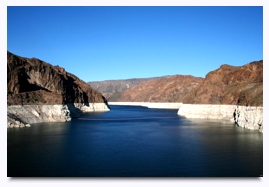 March 30, 2015 —
Drought Hits Lake Mead, Lake Tahoe — Drought conditions are wreaking havoc with Nevada’s lakes and rivers. The Reno Gazette-Journal reported Tuesday that the mountain snowpack this year is the ‘worst in a century.’
March 30, 2015 —
Drought Hits Lake Mead, Lake Tahoe — Drought conditions are wreaking havoc with Nevada’s lakes and rivers. The Reno Gazette-Journal reported Tuesday that the mountain snowpack this year is the ‘worst in a century.’
The Lake Tahoe Basin’s snowpack was only 3 percent of normal for the date and the Truckee River Basin’s was measured at 14 percent. . . . Pat Mulroy, the senior fellow for climate adaptation and environmental policy at Brookings Mountain West, told KNPR’s State of Nevada that when it comes to water supply in the West there is not one single solution — KNPR
 (19.38 min) (19.38 min)
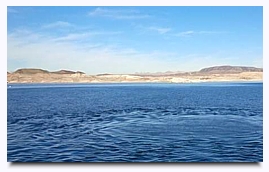 March 30, 2015 — Work on $650 million Lake Mead pump station starts — On an island at Lake Mead that stopped being an island more than a decade ago, the Southern Nevada Water Authority is about to launch the next phase of a 12-year building binge expected to last until 2020 and cost almost $1.5 billion. Design work is underway for a new $650 million deep-water pumping station that will draw from the very bottom of the lake. Seven construction firms have bid to build the facility on Lake Mead’s Saddle Island, which scarcely qualifies as a peninsula these days with the reservoir approaching another historic low — RJ.com
March 30, 2015 — Work on $650 million Lake Mead pump station starts — On an island at Lake Mead that stopped being an island more than a decade ago, the Southern Nevada Water Authority is about to launch the next phase of a 12-year building binge expected to last until 2020 and cost almost $1.5 billion. Design work is underway for a new $650 million deep-water pumping station that will draw from the very bottom of the lake. Seven construction firms have bid to build the facility on Lake Mead’s Saddle Island, which scarcely qualifies as a peninsula these days with the reservoir approaching another historic low — RJ.com
March 30, 2015 — Colorado’s snow is dust-free for the first time in a decade — Last March, while kayaking the sandstone labyrinth of Utah’s San Juan River, I was punched in the face with a wall of wind. It howled up-canyon with a biting ferocity, carrying particles of red sand that scoured our faces and forced us into a cave for hours to seek shelter. The next day, as we drove home to Colorado, it followed us . . . hcn.org
 March 30, 2015 — What severe drought in the Colorado River Basin looks like — Lake Powell, one of the nation’s largest reservoirs, is now below 45 percent of its capacity. Straddling the border between Utah and Arizona, the man-made reservoir is part of the Colorado Water Basin that supplies water to 40 million people. Lake Powell stores water from states in the upper Colorado basin — New Mexico, Utah, Colorado and Wyoming — for the states in the lower basin: Nevada, Arizona and California. Along with generating electricity, the reservoir also protects the Hoover Dam and Lake Mead from flooding — WashingtonPost.com
March 30, 2015 — What severe drought in the Colorado River Basin looks like — Lake Powell, one of the nation’s largest reservoirs, is now below 45 percent of its capacity. Straddling the border between Utah and Arizona, the man-made reservoir is part of the Colorado Water Basin that supplies water to 40 million people. Lake Powell stores water from states in the upper Colorado basin — New Mexico, Utah, Colorado and Wyoming — for the states in the lower basin: Nevada, Arizona and California. Along with generating electricity, the reservoir also protects the Hoover Dam and Lake Mead from flooding — WashingtonPost.com
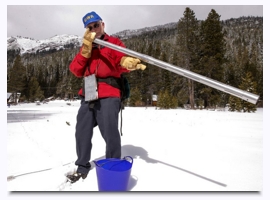 March 28, 2015 —
California drought: Sierra Nevada snowpack hits historic low — The abominable snowpack in the Sierra Nevada reached an unprecedented low this week, dipping below the historic lows in 1977 and 2014 for the driest winter in 65 years of record-keeping.
Electronic surveys show the water content of the snow throughout the Sierra is a shocking 8 percent of the historical average for this time of year, by far the driest it has been since 1950, the year record-keeping began . . . SFgate.com
March 28, 2015 —
California drought: Sierra Nevada snowpack hits historic low — The abominable snowpack in the Sierra Nevada reached an unprecedented low this week, dipping below the historic lows in 1977 and 2014 for the driest winter in 65 years of record-keeping.
Electronic surveys show the water content of the snow throughout the Sierra is a shocking 8 percent of the historical average for this time of year, by far the driest it has been since 1950, the year record-keeping began . . . SFgate.com
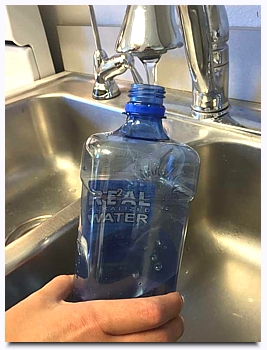 March 25, 2015 — Las Vegas Water Tapped For NV Assemblyman's Bottling Business — Many people don't think twice about what's in that bottle of water they just bought at the grocery store. The taste, compared to tap water, might be worth it. But in a recent article in Desert Companion, one of those bottles was looked at a little more closely.
March 25, 2015 — Las Vegas Water Tapped For NV Assemblyman's Bottling Business — Many people don't think twice about what's in that bottle of water they just bought at the grocery store. The taste, compared to tap water, might be worth it. But in a recent article in Desert Companion, one of those bottles was looked at a little more closely.
On the back of the label of Real Water - a bottle sold in many grocery stores around town - it says in fine black print: "Source of water: Las Vegas Valley Water District." . . . There's also the moral argument of bottling water in one of the driest cities in the country - which Howard Watts, communications specialist for the Great Basin Water Network, says is "highly irresponsible." — KNPR.org
 (19.22 min) (19.22 min)
 March 22, 2015 — Water expert discusses actions Southern Nevada has taken and what we should plan for — Lake Mead’s elevation is just 1,087 feet above sea level and dropping steadily. Another 12 feet and the most severe drought-protection program the Southwest has ever seen will be triggered. If and when Lake Mead hits 1,075 feet, the government will declare a federal water shortage for the seven states that draw water from the Colorado River, forcing Nevada and the others to limit water use.
March 22, 2015 — Water expert discusses actions Southern Nevada has taken and what we should plan for — Lake Mead’s elevation is just 1,087 feet above sea level and dropping steadily. Another 12 feet and the most severe drought-protection program the Southwest has ever seen will be triggered. If and when Lake Mead hits 1,075 feet, the government will declare a federal water shortage for the seven states that draw water from the Colorado River, forcing Nevada and the others to limit water use.
Worse, a report by climate scientists and NASA predicts the Southwest will be in a decades-long drought by midcentury — the worst in 1,000 years. Despite the sobering predictions, former Las Vegas water czar Pat Mulroy is confident life will go on in the West — Las Vegas Sun
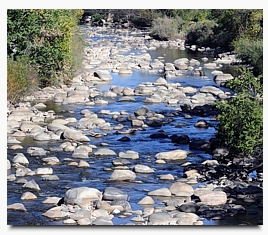 March 19, 2015 — Cut water use in Reno-Sparks now, TMWA says — With the drought in its fourth year and this winter shaping up to be the driest yet, the major water provider for the Reno-Sparks area is asking folks to begin curbing water use immediately. The 118,000 homes and businesses served by the Truckee Meadows Water Authority are asked to reduce all water use by at least 10 percent from amounts consumed in 2013.
March 19, 2015 — Cut water use in Reno-Sparks now, TMWA says — With the drought in its fourth year and this winter shaping up to be the driest yet, the major water provider for the Reno-Sparks area is asking folks to begin curbing water use immediately. The 118,000 homes and businesses served by the Truckee Meadows Water Authority are asked to reduce all water use by at least 10 percent from amounts consumed in 2013.
Also in response to continuing drought, the authority is expected by July 1 to begin tapping backup drought supplies stored in upstream reservoirs and to step up groundwater pumping to meet summer water demand — RGJ.com
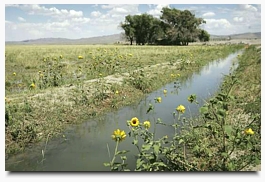 March 17, 2015 — Lawsuit alleges Vegas water authority cooked books on rural ranch profits — A former employee is accusing the Southern Nevada Water Authority of cooking its books to hide big losses at the ranches it owns in White Pine County. In a lawsuit filed March 6 against the authority and the Las Vegas Valley Water District, retired comptroller Randall Buie says he was forced out of his job after he refused to go along with creative accounting he considered fraudulent and misleading. Buie claims he was “harassed and bullied” into creating special financial reports that dramatically understated expenses to make the ranches look like they were turning a small profit when they were actually losing roughly $2 million per year — Las Vegas Review Journal
March 17, 2015 — Lawsuit alleges Vegas water authority cooked books on rural ranch profits — A former employee is accusing the Southern Nevada Water Authority of cooking its books to hide big losses at the ranches it owns in White Pine County. In a lawsuit filed March 6 against the authority and the Las Vegas Valley Water District, retired comptroller Randall Buie says he was forced out of his job after he refused to go along with creative accounting he considered fraudulent and misleading. Buie claims he was “harassed and bullied” into creating special financial reports that dramatically understated expenses to make the ranches look like they were turning a small profit when they were actually losing roughly $2 million per year — Las Vegas Review Journal
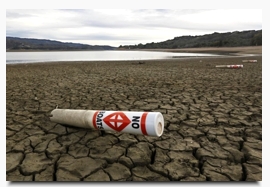 March 16, 2015 — California’s ridiculous run of record heat inflaming dire water situation — As California’s water supply is steadily dwindling, it is piling up warm weather records at a feverish pace. Disturbingly, the weather pattern responsible for this hot, dry pattern shows no signs of relenting as scientists gain more clues into what’s causing it. In a must-read Op-Ed published in the LA Times last Thursday, NASA’s Jay Famiglietti called for immediate water rationing in laying out several depressing facts about the state of water affairs in California, due to the drought . . . WashingtonPost.com
March 16, 2015 — California’s ridiculous run of record heat inflaming dire water situation — As California’s water supply is steadily dwindling, it is piling up warm weather records at a feverish pace. Disturbingly, the weather pattern responsible for this hot, dry pattern shows no signs of relenting as scientists gain more clues into what’s causing it. In a must-read Op-Ed published in the LA Times last Thursday, NASA’s Jay Famiglietti called for immediate water rationing in laying out several depressing facts about the state of water affairs in California, due to the drought . . . WashingtonPost.com
 March 12, 2015 — Forecasters predict another down year for Lake Mead — Stop us if you’ve heard this one before: A lackluster year so far on the Colorado River has local water managers and National Park Service officials bracing for further declines at Lake Mead. According to the latest federal forecast, released Wednesday, the reservoir is expected to fall to a new record low next month and slip downward from there, shedding a total of about 20 feet through June 2016. The bleak new estimate is based on current projections pointing to below-average flows on the Colorado in the coming months, as the snow pack melts in the mountains that feed the river and its tributaries — RJ.com
March 12, 2015 — Forecasters predict another down year for Lake Mead — Stop us if you’ve heard this one before: A lackluster year so far on the Colorado River has local water managers and National Park Service officials bracing for further declines at Lake Mead. According to the latest federal forecast, released Wednesday, the reservoir is expected to fall to a new record low next month and slip downward from there, shedding a total of about 20 feet through June 2016. The bleak new estimate is based on current projections pointing to below-average flows on the Colorado in the coming months, as the snow pack melts in the mountains that feed the river and its tributaries — RJ.com
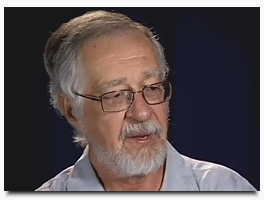 March 11, 2015 — Growth and Water Loss Spell Sun Belt Trouble — LAS VEGAS (CN) – Population growth and drought in the Sun Belt are forcing residents and governments to find new water sources, particularly in the Las Vegas area, which has grown from around 25,000 in the 1950s to nearly 2 million today. More growth is expected in Las Vegas Valley, which is near the largest reservoir in the United States. A proposed 263-mile pipeline that would send water from the Great Basin to Las Vegas has met furious opposition and is tied up in state and federal courts. "Whiskey is for drinking, water is for fighting," said Center for Biological Diversity scientist Rob Mrowka, quoting Mark Twain on water in the parched West . . . [Mrowka] says the proposed pipeline is among many issues facing the Desert Southwest as well as Las Vegas and could have a significant impact on far more than just population centers in the Southwest. "The big picture is: What is sustainable and viable for the American Southwest, given climate change?" Mrowka said. —courthousenews.com
March 11, 2015 — Growth and Water Loss Spell Sun Belt Trouble — LAS VEGAS (CN) – Population growth and drought in the Sun Belt are forcing residents and governments to find new water sources, particularly in the Las Vegas area, which has grown from around 25,000 in the 1950s to nearly 2 million today. More growth is expected in Las Vegas Valley, which is near the largest reservoir in the United States. A proposed 263-mile pipeline that would send water from the Great Basin to Las Vegas has met furious opposition and is tied up in state and federal courts. "Whiskey is for drinking, water is for fighting," said Center for Biological Diversity scientist Rob Mrowka, quoting Mark Twain on water in the parched West . . . [Mrowka] says the proposed pipeline is among many issues facing the Desert Southwest as well as Las Vegas and could have a significant impact on far more than just population centers in the Southwest. "The big picture is: What is sustainable and viable for the American Southwest, given climate change?" Mrowka said. —courthousenews.com
 March 09, 2015 — California is pumping water that fell to Earth 20,000 years ago — By now, the impacts of California’s unchecked groundwater pumping are well-known: the dropping water levels, dried-up wells and slowly sinking farmland in parts of the Central Valley. But another consequence gets less attention, one measured not by acre-feet or gallons-per-minute but the long march of time . . . “We are withdrawing from a fairly large bank account,” said Tom Myers, a hydrogeologic consultant in Reno, Nevada, who has worked in Southern California. “But we are withdrawing from it a lot faster than we are putting back in. The problem is we don’t know how close it is to empty.” — RevealNews.org
March 09, 2015 — California is pumping water that fell to Earth 20,000 years ago — By now, the impacts of California’s unchecked groundwater pumping are well-known: the dropping water levels, dried-up wells and slowly sinking farmland in parts of the Central Valley. But another consequence gets less attention, one measured not by acre-feet or gallons-per-minute but the long march of time . . . “We are withdrawing from a fairly large bank account,” said Tom Myers, a hydrogeologic consultant in Reno, Nevada, who has worked in Southern California. “But we are withdrawing from it a lot faster than we are putting back in. The problem is we don’t know how close it is to empty.” — RevealNews.org
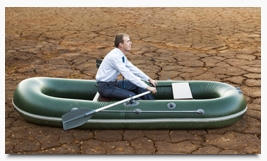 March 09, 2015 — Can Climate Action Plans Combat Megadrought and Save the Colorado River? — If a city’s water supply is threatened by climate change, should that city enact a strong climate action plan? I believe the answer is yes, but few cities throughout the Colorado River basin are moving forward aggressively to address climate change even though the threat is increasing every year — Gary Wockner, PhD, is executive director of the Save The Colorado River Campaign.
March 09, 2015 — Can Climate Action Plans Combat Megadrought and Save the Colorado River? — If a city’s water supply is threatened by climate change, should that city enact a strong climate action plan? I believe the answer is yes, but few cities throughout the Colorado River basin are moving forward aggressively to address climate change even though the threat is increasing every year — Gary Wockner, PhD, is executive director of the Save The Colorado River Campaign.
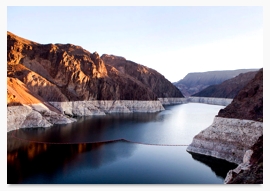 March 05, 2015 — Sin City's Thirst Is Drying Up the West — It’s Mammon versus Mormon as Las Vegas and its glittering towers of glass and greed seek to quench their growing thirst by draining billions of gallons of water from under the feet of ranchers whose cattle help feed the church’s poor. The biblical battle across 275 miles of treeless ridges and baked salt flats comes as the western U.S. faces unprecedented droughts linked to climate change. The surface of Las Vegas’s main source of water, Lake Mead, sits more than 100 feet below Hoover Dam’s spillways after reaching the lowest mark last summer since the dam was filled — by Edvard Pettersson, Blommberg
March 05, 2015 — Sin City's Thirst Is Drying Up the West — It’s Mammon versus Mormon as Las Vegas and its glittering towers of glass and greed seek to quench their growing thirst by draining billions of gallons of water from under the feet of ranchers whose cattle help feed the church’s poor. The biblical battle across 275 miles of treeless ridges and baked salt flats comes as the western U.S. faces unprecedented droughts linked to climate change. The surface of Las Vegas’s main source of water, Lake Mead, sits more than 100 feet below Hoover Dam’s spillways after reaching the lowest mark last summer since the dam was filled — by Edvard Pettersson, Blommberg
March 03, 2015 — The water czar who reshaped Colorado River politics — Las Vegas' Pat Mulroy initiated an era of deal-making that may buffer against catastrophic drought. [PDF - 10 MB] The morning of Tuesday, Sept. 27, 2005, brought hints of a classic New Mexico fall, with a forecast high in the 80s and a trace of rain. But in a Wyndham Hotel at the Albuquerque airport, not far from where the rugged buttress of the Sandia Mountains rose into the autumn sky, life was anything but serene. Tensions were rising around a conference table in a rented meeting room, and the catered sandwich platters sat forgotten. For more than a year, the Southwest's top water bosses had been shuttling between airport hotels all over the region. Regulators from the seven states that depend on the Colorado River, together with major urban water-agency managers, faced a collective crisis that threatened the water supply of nearly 40 million people and a $1.4 trillion economy:A six-year drought that showed no signs ofletting up — High Country News – Matt Jenkins
 March 03, 2015 —
Water district signs off on rate hike for Lake Mead pump station —
Las Vegas Valley Water District customers will see their rates go up in each of the next three years to help pay for a new deep-water pumping station at Lake Mead. The Clark County Commission, sitting as the board for the valley’s largest water utility, unanimously approved the rate hike Tuesday.
March 03, 2015 —
Water district signs off on rate hike for Lake Mead pump station —
Las Vegas Valley Water District customers will see their rates go up in each of the next three years to help pay for a new deep-water pumping station at Lake Mead. The Clark County Commission, sitting as the board for the valley’s largest water utility, unanimously approved the rate hike Tuesday.
The increase will begin appearing on bills in January and be phased in through 2018, when it tops out with an increase of almost $5 per month for most residential customers. Commercial customers and others with larger service lines will pay substantially more — RJ.com
March 03, 2015 — Editorial: Utah’s water plan needs to account for climate change — Despite the growing research that less rain and snow will fall here in the coming decades, the people planning Utah's water future have not adjusted their models. A recent study from NASA's Goddard Institute for Space Studies has offered a stark prediction: If the current rates of human-generated emissions continues, there is an 80 percent chance of a 30- to 35-year megadrought in the American southwest. "We will still have natural variability, but happening with a much drier baseline," the study's lead author said. This comes on top of various other predictions that climate change will make Utah a hotter, drier place — Sltrib.com
March 03, 2015 — Expert: overpopulation, city expansion likely cause of future Colorado River Basin water shortages — GRAND CANYON, Ariz. - Experts say conservation efforts like not watering lawns, taking shorter showers, turning off faucets and not washing your vehicle are not going to help in a long-term solution for water shortages along the Colorado River Basin. According to John Weisheit conservation director for Living Rivers, the only thing that will stop water from disappearing is to put the brakes on city expansion and population growth — Havasunews.com
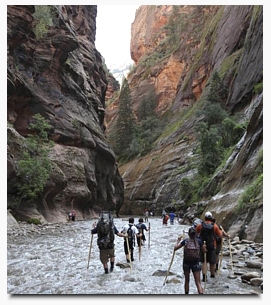 March 02, 2015 — Glass half full? — On Jan. 1, I joined 15 friends on a raft trip down the Colorado River through the Grand Canyon. That morning, our boats were covered in snow; the canyon’s red cliffs, capped with white, looked like giant slabs of frosted carrot cake. The ranger said locals had never seen the place so wintry — hcn.org
March 02, 2015 — Glass half full? — On Jan. 1, I joined 15 friends on a raft trip down the Colorado River through the Grand Canyon. That morning, our boats were covered in snow; the canyon’s red cliffs, capped with white, looked like giant slabs of frosted carrot cake. The ranger said locals had never seen the place so wintry — hcn.org
March 02, 2015 — 6 Ways to Save the Salton Sea and Colorado Delta — With scientific modeling foreshadowing megadroughts in the Southwest and Great Plains, it is imperative policymakers implement freshwater projects along the lower Colorado River, in particular, the Salton Sea, a 376-square-mile freshwater agricultural sump in southeastern California, and in the Colorado River Delta where the waterway ends its journey in the Baja California desert — NationalGeographic.com
Februry 28, 2015 — Growing Utah town wants even more water via pipeline — ST. GEORGE, Utah – This corner of the Mojave Desert that locals call "Color Country" is a fast-growing little retirement haven with a water problem. With an application now before federal regulators, state and county officials hope to assure continued growth via a 140-mile pipeline from the Colorado River at Lake Powell — Azcentral.com
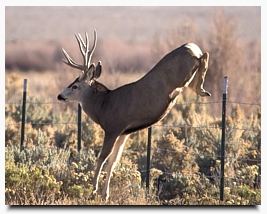 February 28, 2015 — Ongoing battle between urban and rural water users [Ranchers like Tom and Dean Baker are fighting to retain water rights on the Utah-Nevada border] — BAKER, Nev. – Black sand gurgled like a mud volcano from the bottom of Clay Springs, pushed aside by crystalline water rising to the desert's surface. Rancher Tom Baker stood in the marshy pasture beside one of the few oases that have kept his family ranching cattle across the Utah-Nevada line just downhill from Great Basin National Park. Cows romped and chewed in the green island surrounded by a sea of brittle brown greasewood. Baker shook his head in disgust. "To think you're going to take all the water out of the ground (to build) a few more blocks in Las Vegas," he said, practically spitting out his words. The urban Southwest has a water problem, and residents of this barely populated valley fear they'll be among the first casualties — Azcentral.com
February 28, 2015 — Ongoing battle between urban and rural water users [Ranchers like Tom and Dean Baker are fighting to retain water rights on the Utah-Nevada border] — BAKER, Nev. – Black sand gurgled like a mud volcano from the bottom of Clay Springs, pushed aside by crystalline water rising to the desert's surface. Rancher Tom Baker stood in the marshy pasture beside one of the few oases that have kept his family ranching cattle across the Utah-Nevada line just downhill from Great Basin National Park. Cows romped and chewed in the green island surrounded by a sea of brittle brown greasewood. Baker shook his head in disgust. "To think you're going to take all the water out of the ground (to build) a few more blocks in Las Vegas," he said, practically spitting out his words. The urban Southwest has a water problem, and residents of this barely populated valley fear they'll be among the first casualties — Azcentral.com
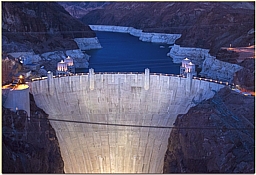 February 28, 2015 — As the River Runs Dry: The Southwest's water crisis — LAS VEGAS – The patroller stopped his water district truck and grabbed his camcorder. "Here we go," he said, sliding from the cab and pointing his lens at the fine spray of water and rainbow rising from pop-up sprinklers on the lawn of a low-slung ranch home. Thursday," he spoke, recording the day as evidence. No watering allowed on Thursdays. Welcome to the future, where every drop of Colorado River water is guarded and squeezed. Only here, in the city that gets 90 percent of its water from the fickle and fading river, the future is now — Azcentral.com
February 28, 2015 — As the River Runs Dry: The Southwest's water crisis — LAS VEGAS – The patroller stopped his water district truck and grabbed his camcorder. "Here we go," he said, sliding from the cab and pointing his lens at the fine spray of water and rainbow rising from pop-up sprinklers on the lawn of a low-slung ranch home. Thursday," he spoke, recording the day as evidence. No watering allowed on Thursdays. Welcome to the future, where every drop of Colorado River water is guarded and squeezed. Only here, in the city that gets 90 percent of its water from the fickle and fading river, the future is now — Azcentral.com
 February 26, 2015 — Pioneering Desert Fish Biologist, Researcher, and Staunch Advocate for
Desert Ecosystems Dr. Jim Deacon Has Died — Over the course of his 55-year career, Deacon focused on the conservation of desert fish and other freshwater species and on sustainable water-use advocacy in the Southwest. His work contributed to the protection of several threatened and endangered aquatic species, helped secure water rights for Death Valley and Zion national parks, and helped create Ash Meadows and Moapa national wildlife refuges in Nevada — biologicaldiversity.org
February 26, 2015 — Pioneering Desert Fish Biologist, Researcher, and Staunch Advocate for
Desert Ecosystems Dr. Jim Deacon Has Died — Over the course of his 55-year career, Deacon focused on the conservation of desert fish and other freshwater species and on sustainable water-use advocacy in the Southwest. His work contributed to the protection of several threatened and endangered aquatic species, helped secure water rights for Death Valley and Zion national parks, and helped create Ash Meadows and Moapa national wildlife refuges in Nevada — biologicaldiversity.org
February 25, 2015 — Business: Real thirst: With alkalized water brands tapping our precious local supply, has the bottled water business gone too far? — A few months ago in her Carson City home, Abby Johnson’s cleaning lady held up a bottle of Real Water and declared that the stuff had changed her life — she was sleeping better and feeling more energetic since she started drinking it, she said. “Let me see that,” Johnson replied, examining the bottle. Amid the fine print, she saw these words: “Source of water: Las Vegas Valley Water District.” — Story by Heidi Kyser
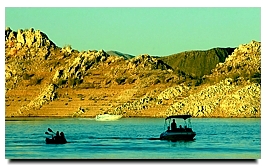 February 25, 2015 — Top official delivers bleak forecast for Lake Mead — WASHINGTON — Nevada faces “significant possibilities” of water shortages if drought on the Colorado River persists into the next two years, according to an ominous forecast delivered Wednesday by a top government official. Michael Connor, deputy secretary of the Interior Department, said there is a 20 percent chance of shortages in Nevada and Arizona in 2016 if levels of Lake Mead and Lake Powell continue to drop, “and it goes up to almost 50 percent after that — RJ.com
February 25, 2015 — Top official delivers bleak forecast for Lake Mead — WASHINGTON — Nevada faces “significant possibilities” of water shortages if drought on the Colorado River persists into the next two years, according to an ominous forecast delivered Wednesday by a top government official. Michael Connor, deputy secretary of the Interior Department, said there is a 20 percent chance of shortages in Nevada and Arizona in 2016 if levels of Lake Mead and Lake Powell continue to drop, “and it goes up to almost 50 percent after that — RJ.com
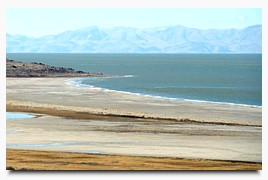 February 22, 2015 — Will Utah be ready for a drier, hotter climate?— The specter of drought hanging over the Southwest is already pretty dire, with forests drying out into beetle-killed tinderboxes and reservoir levels plunging. But the current dry spell may barely register in comparison with what has happened in the distant past and could happen in the near future, according to research released this month. And we may have ourselves to blame — sltrib.com
February 22, 2015 — Will Utah be ready for a drier, hotter climate?— The specter of drought hanging over the Southwest is already pretty dire, with forests drying out into beetle-killed tinderboxes and reservoir levels plunging. But the current dry spell may barely register in comparison with what has happened in the distant past and could happen in the near future, according to research released this month. And we may have ourselves to blame — sltrib.com
February 20, 2015 —  Record West Coast drought shows no signs of easing — The flip side to the frigid weather in much of the U.S. is record warmth in the West. Parts of Alaska hit the mid-50s this week. And it's dry -- 93 percent of California is in a severe drought that's going on four years — CBS News Record West Coast drought shows no signs of easing — The flip side to the frigid weather in much of the U.S. is record warmth in the West. Parts of Alaska hit the mid-50s this week. And it's dry -- 93 percent of California is in a severe drought that's going on four years — CBS News
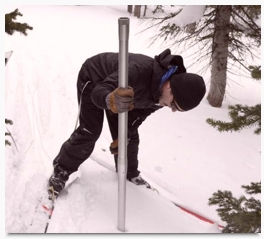 February 18, 2015 — Colorado mountain snow is bright spot during drought in West: DENVER — Snowpack in the mountain valleys where the Colorado River originates was only a little below normal on Wednesday, marking one of the few bright spots in an increasingly grim drought gripping much of the West. Measurement stations in western Colorado showed the snowpack at 90 percent of the long-term average.
By contrast, reporting stations in the Sierra Nevada range in drought-stricken California showed snowpack at 50 percent or less in early February, the most recent figures available. Some detected no snow at all — Abqjournal.com
February 18, 2015 — Colorado mountain snow is bright spot during drought in West: DENVER — Snowpack in the mountain valleys where the Colorado River originates was only a little below normal on Wednesday, marking one of the few bright spots in an increasingly grim drought gripping much of the West. Measurement stations in western Colorado showed the snowpack at 90 percent of the long-term average.
By contrast, reporting stations in the Sierra Nevada range in drought-stricken California showed snowpack at 50 percent or less in early February, the most recent figures available. Some detected no snow at all — Abqjournal.com
 February 12, 2015 — Study: Snake Valley groundwater development unsustainable — SALT LAKE CITY – A hydrologic study commissioned by the Utah Legislature seven years ago concludes any significant groundwater development in Snake Valley and adjacent areas is not sustainable and even current pumping is drawing down the aquifer. The study, released Thursday, compiled data from a monitoring network developed by the Utah Geological Survey that includes wells placed in farm land, ranching areas, springs and at remote sites. A total of 76 wells recorded water levels hourly and six sites featured spring flow gauges . . . Simeon Herskovitz, an attorney who has represented multiple groups and individuals suing Nevada over the issue, praised the report's findings and said it should be evidence enough to compel the Southern Nevada Water Authority to back off its groundwater pumping plan — DesertNews.com
February 12, 2015 — Study: Snake Valley groundwater development unsustainable — SALT LAKE CITY – A hydrologic study commissioned by the Utah Legislature seven years ago concludes any significant groundwater development in Snake Valley and adjacent areas is not sustainable and even current pumping is drawing down the aquifer. The study, released Thursday, compiled data from a monitoring network developed by the Utah Geological Survey that includes wells placed in farm land, ranching areas, springs and at remote sites. A total of 76 wells recorded water levels hourly and six sites featured spring flow gauges . . . Simeon Herskovitz, an attorney who has represented multiple groups and individuals suing Nevada over the issue, praised the report's findings and said it should be evidence enough to compel the Southern Nevada Water Authority to back off its groundwater pumping plan — DesertNews.com
[Direct Link to the Study - 294 Pages, 82.5MB]
February 12, 2015 — Southwest now 50 percent, study concludes — The chance of a "megadrought" gripping the Southwest for more than 30 years has increased to 50 percent, scientists say, which means bad news for California's already parched landscape. The odds of a 10-year drought afflicting the southwestern U.S. have increased to 80 percent, according to a new study by Cornell University, the University of Arizona and the U.S. Geological Survey — SacBee.com
   More Coverage: Warming Pushes Western U.S. Toward Driest Period in 1,000 Years — Astrobio.net More Coverage: Warming Pushes Western U.S. Toward Driest Period in 1,000 Years — Astrobio.net
   More Coverage: Worst Drought in 1,000 Years Predicted for American West — National Geographics More Coverage: Worst Drought in 1,000 Years Predicted for American West — National Geographics
February 11, 2015 — We have lots of water; the Colorado River Basin doesn't —Private well owners and suburban water companies and wildlife living around Tucson are reaping the benefits of this fall's and winter's robust rainfall. It's been raining at nearly twice the normal rate since October. But Tucson Water customers aren't so lucky, because the snowpack that feeds their prime water source is looking a lot less lush right now. That's the Upper Colorado River Basin, whose streams and mountains provide the raw material for the Central Arizona Project water that leaves Lake Havasu for a 336-mile journey by pipeline and concrete canal to Phoenix and Tucson —tucson.com
February 09, 2015 — Supreme Court decision keeps water pipeline dry for now — The Nevada Supreme Court has dismissed an appeal of a lower court ruling that effectively stripped the Southern Nevada Water Authority of water rights for its controversial pipeline from eastern Nevada. In 2013, Senior District Judge Robert Estes ruled that the state’s chief water regulator failed to adequately support a decision two years earlier to allow the authority to sink its wells in four lonesome valleys in Lincoln and White Pine counties. In an unpublished order issued Friday, the Supreme Court declared that Estes’ decision was not subject to appeal, a move that could force State Engineer Jason King to follow through on additional work the judge requested — Las Vegas Review Journal Read GBWN Press Release! [2 Page PDF]
   More Coverage — AP More Coverage — AP
February 08, 2015 — Public meeting Monday on $650M pumping station, proposed rate increase . . . Southern Nevada water users will have the opportunity Monday to learn more about a proposed $650 million low-lake level pumping station and a proposed rate increase to pay for the project — Mynews3.com
February 07, 2015 — Climate change will increase evaporation of Colorado River —The Colorado River faces a dual threat from climate change as rising temperatures increase the demand for irrigation water and accelerate evaporation at the river’s two largest reservoirs. So says a new report from the U.S. Bureau of Reclamation, which predicts an 8 percent increase in irrigation demand on the lower half of the Colorado River Basin and a 10 percent increase in evaporation from Lake Mead by 2080 —RJ.com
February 04, 2015 — [Nevada] Legislature to attempt to fix Pahrump water concerns — he Nevada Division of Water Resources has proposed a controversial fix to Pahrump’s projected water woes by the crafting of two bills, scheduled to be heard by the state Legislature on Feb. 11. State engineer Jason King, in pre-filed Senate Bill 65, has asked that Chapter 533 of Nevada’s Revised Statutes relating to the adjudication of vested water rights and provisions relating to underground water be “modernized.” — pvtimes.com
February 02, 2015 — Great Salt Lake at near-record low level — There's a new normal at the Great Salt Lake. Hundreds of square miles of lakebed are exposed. Boat marinas are nearly landlocked. Islands have become peninsulas connected to the mainland. Salinity is rising in the south arm — endangering biodiversity and the brine shrimp and minerals industries. Water-sucking plants are growing on the shore. And mercury and other toxic metals normally trapped deep in the lower layers of the lake are swirling closer to the surface and drying into dust on the shore.[See photos] sltrib.com
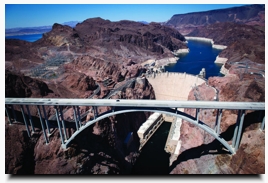 February 02, 2015 — Colo. River shortage may happen by 2017 — There is a 61 percent chance of the U.S. Interior Department declaring a shortage on the lower Colorado River by 2017, a Central Arizona Project official told state lawmakers Thursday. That declaration would trigger a cut in water that in recent years has been stored underground in anticipation of a shortage as well as water allocated to central Arizona agriculture, Deputy General Manager Marie Pearthree told the House Agriculture, Water and Lands Committee. “Municipal and industrial water to cities do not take a shortage unless Lake Mead drops significantly farther,” she told Cronkite News after her talk — yumasun.com
February 02, 2015 — Colo. River shortage may happen by 2017 — There is a 61 percent chance of the U.S. Interior Department declaring a shortage on the lower Colorado River by 2017, a Central Arizona Project official told state lawmakers Thursday. That declaration would trigger a cut in water that in recent years has been stored underground in anticipation of a shortage as well as water allocated to central Arizona agriculture, Deputy General Manager Marie Pearthree told the House Agriculture, Water and Lands Committee. “Municipal and industrial water to cities do not take a shortage unless Lake Mead drops significantly farther,” she told Cronkite News after her talk — yumasun.com
January 24, 2015 — LETTER TO THE EDITOR: Some questions about our water — Despite constantly hearing from both past and present water bosses that Las Vegas has nothing to worry about and that the Southwest must and will work together to solve the Colorado River crisis, reading between the lines of the official statements leaves more questions than answers— Howard Watts III, Las Vegas
January 24, 2015 — Contaminated site near Lake Mead to get $1.1B for cleanup — Billions of dollars from an environmental contamination settlement now can be disbursed nationwide, including for cleanup of former uranium sites on the Navajo Nation and a chemical manufacturing site near Lake Mead — AP
January 20, 2015 — Expert panel dives into Colorado River challenges — A panel of Colorado River specialists came together Wednesday night to share insights into a short but far from simple question: Can the Colorado River Survive? Although the group that entertained a large crowd at ASU Havasu’s Daytona Gym didn’t solve all of the river’s problems, they offered diverse views and insightful thought — Havansunews.com
January 16, 2015 — No gambling in Las Vegas – at least when it comes to the future of Colorado River Water rights — Every December, the members of the Colorado River Water Users Association – including water users, federal, tribal, state and local regulators, irrigation districts, engineers, conservationists, and others from all over the southwestern United States — gather at Caesar’s Palace in Las Vegas, Nevada to get wild and talk about Colorado River water policy for a few days. 2014 was no exception, and as tends to happen, a significant announcement was made: the major water users of the Colorado River in the Lower Colorado River Basin (Lower Basin) entered a Memorandum of Understanding (MOU) to take new, additional actions designed to help avoid serious impacts resulting from sustained drought in the Lower Basin —Lexology.com [Print Version]
January 16, 2015 — Waste not, want not (water) working for area golf courses — More than 900 acres of grass have been removed from Southern Nevada golf courses in the last 12 years, conserving more than 2 billion gallons of water — RJ.com
January 15, 2015 — Exceptional Drought Expands In Sacramento Valley, Sierra Nevada — CapRaido.org
January 14, 2015 —One River’s Outsize Impact — and the Threat of Drought — [The Colorado Supplies Economic Lifeline to Seven States but Its Future Is Threatened] — A new study for the first time quantifies the economic importance of Colorado River water to seven Western states—and the dire outcome should ongoing droughts dry up even a portion of it — wsj.com
More Coverage:
Study details impacts to Utah if Colorado River runs dry — Ksl.com
Report: Colorado River Vital to Arizona's Economy — PublicNewsService.org
 January 14, 2015 — Stop the War Against the Colorado River As we head into 2015, the health of Colorado River is at extreme risk as is the economies of states in the lower part of the river in Arizona, Nevada and California that depend on flows in the river. Drought continues in the Southwest U.S., climate change is predicted to decrease river flows an additional 10 to 30 percent, and the level of Lake Mead—the reservoir that holds water for much of Nevada, Arizona and Southern California—continues to fall with no end in sight . . . The Colorado River is a patient in the emergency room. If the patient is bleeding out, you don’t cut open a new artery to heal it, and that’s what the proposed projects by the upstream states would do — By Gary Wockner, PhD, is executive director of the Save The Colorado River Campaign.
January 14, 2015 — Stop the War Against the Colorado River As we head into 2015, the health of Colorado River is at extreme risk as is the economies of states in the lower part of the river in Arizona, Nevada and California that depend on flows in the river. Drought continues in the Southwest U.S., climate change is predicted to decrease river flows an additional 10 to 30 percent, and the level of Lake Mead—the reservoir that holds water for much of Nevada, Arizona and Southern California—continues to fall with no end in sight . . . The Colorado River is a patient in the emergency room. If the patient is bleeding out, you don’t cut open a new artery to heal it, and that’s what the proposed projects by the upstream states would do — By Gary Wockner, PhD, is executive director of the Save The Colorado River Campaign.
Related Information
Colorado Launch A $20 BILLION Water War Against State’s Rivers?
Is Las Vegas betting the Colorado River will go dry?
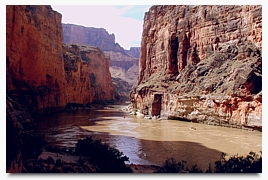 January 09, 2015 — A Think Tank for the Colorado River’s Future — Have you ever been in a work meeting or a classroom when you realize that you – and probably everyone else in the room – seemed to be talking at cross purposes and had lost track of the problem you were trying to solve? That’s how many of the water experts, local communities, and conservationists focused on the water woes of the Colorado River have come to feel in recent years — NationalGeographic.com. Related Information — Charting a New Course for the Colorado River: A Summary of Guiding Principles (December, 2014) — ColoradoRiverSearchGroup.org
January 09, 2015 — A Think Tank for the Colorado River’s Future — Have you ever been in a work meeting or a classroom when you realize that you – and probably everyone else in the room – seemed to be talking at cross purposes and had lost track of the problem you were trying to solve? That’s how many of the water experts, local communities, and conservationists focused on the water woes of the Colorado River have come to feel in recent years — NationalGeographic.com. Related Information — Charting a New Course for the Colorado River: A Summary of Guiding Principles (December, 2014) — ColoradoRiverSearchGroup.org
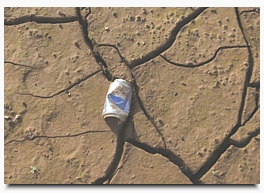 January 08, 2015 — 2014 was California’s hottest year, and it wasn’t even close California not only sweated through its hottest year on record in 2014 but obliterated the previous mark by nearly 2 degrees, federal scientists said Thursday, while experiencing firsthand some of the worst fears of a warming planet — from intensified drought to melting snowpack — Sfgate.com
January 08, 2015 — 2014 was California’s hottest year, and it wasn’t even close California not only sweated through its hottest year on record in 2014 but obliterated the previous mark by nearly 2 degrees, federal scientists said Thursday, while experiencing firsthand some of the worst fears of a warming planet — from intensified drought to melting snowpack — Sfgate.com
Go To Water Grab News Archives — 2014
Archives News Home Page
GBWN Home Page
|
 December 28, 2015 —
December 28, 2015 —  December 21, 2015 —
December 21, 2015 — December 12, 2015 —
December 12, 2015 — 
 December 12, 2015 —
December 12, 2015 —  December 12, 2015 —
December 12, 2015 —  December 10, 2015 —
December 10, 2015 —  November 20, 2015 —
November 20, 2015 —  November 18, 2015 —
November 18, 2015 —  November 16, 2015 —
November 16, 2015 — October 27, 2015 —
October 27, 2015 —  October 26, 2015 —
October 26, 2015 —  October 03, 2015 —
October 03, 2015 —  September 24, 2015 — Governor's Drought Forum — Great Basin Water Network‘s Howard Watts stated his appreciation to be “in a more relaxed environment” where he’s not battling many of the folks in this room at a #NVLeg hearing or in court. He then thanked SNWA for its work on “The Third Straw”… As there looks to be no remaining excuse for any Snake Valley water grab. Watts reiterated Davis’ call for greater conservation and the end of “use it or lose it”. He then called for fairer water rates that ensure the biggest water users pay their fair share and a new statewide water plan that properly addresses this large statewide problem.
September 24, 2015 — Governor's Drought Forum — Great Basin Water Network‘s Howard Watts stated his appreciation to be “in a more relaxed environment” where he’s not battling many of the folks in this room at a #NVLeg hearing or in court. He then thanked SNWA for its work on “The Third Straw”… As there looks to be no remaining excuse for any Snake Valley water grab. Watts reiterated Davis’ call for greater conservation and the end of “use it or lose it”. He then called for fairer water rates that ensure the biggest water users pay their fair share and a new statewide water plan that properly addresses this large statewide problem.  September 24, 2015 —
September 24, 2015 —  September 19, 2015 —
September 19, 2015 —  September 22, 2015 —
September 22, 2015 —  September 09, 2015 —
September 09, 2015 —  September 08, 2015 —
September 08, 2015 —  September 03, 2015 —
September 03, 2015 —  August 31, 2015 —
August 31, 2015 —  August 27, 2015 —
August 27, 2015 — August 09, 2015 — [SNWA]
August 09, 2015 — [SNWA] August 02, 2015 —
August 02, 2015 —  July 29, 2015 —
July 29, 2015 —  July 18, 2015 —
July 18, 2015 —  July 16, 2015 —
July 16, 2015 —  July 06, 2015 —
July 06, 2015 —  July 04, 2015 —
July 04, 2015 —  July 01, 2015 —
July 01, 2015 — July 01, 2015 —
July 01, 2015 —  June 28, 2015 —
June 28, 2015 — 
 June 25, 2015 —
June 25, 2015 —  June 24, 2015 —
June 24, 2015 —  June 24, 2015 —
June 24, 2015 — 
 June 17, 2015 —
June 17, 2015 —  June 16, 2015 —
June 16, 2015 — June 15, 2015 —
June 15, 2015 —  June 13, 2015 —
June 13, 2015 —  June 13, 2015 —
June 13, 2015 —  June 09, 2015 —
June 09, 2015 —  June 09, 2015 —
June 09, 2015 —  June 06, 2015 —
June 06, 2015 —  June 05, 2015 —
June 05, 2015 — June 05, 2015 —
June 05, 2015 —  June 02, 2015 —
June 02, 2015 —  June 02, 2015 —
June 02, 2015 —  May 23, 2015 —
May 23, 2015 —  May 20, 2015 —
May 20, 2015 —  May 19, 2015 —
May 19, 2015 —  May 18, 2015 — [Tucson]
May 18, 2015 — [Tucson]  May 12, 2015 —
May 12, 2015 —  May 11, 2015 —
May 11, 2015 —  May 10, 2015 —
May 10, 2015 — May 05, 2015 —
May 05, 2015 — May 04, 2015 —
May 04, 2015 —  May 01, 2015 —
May 01, 2015 —  May 01, 2015 —
May 01, 2015 —  April 29, 2015 —
April 29, 2015 —
 April 27, 2015 — Letter to the editor —
April 27, 2015 — Letter to the editor —  April 27, 2015 —
April 27, 2015 — 
 April 26, 2015 —
April 26, 2015 —  April 23, 2015 —
April 23, 2015 —  April 21, 2015 —
April 21, 2015 — 
 April 14, 2015 —
April 14, 2015 —  April 13, 2015 —
April 13, 2015 —  April 05, 2015 —
April 05, 2015 —  April 05, 2015 —
April 05, 2015 — 
 March 30, 2015 —
March 30, 2015 —  March 30, 2015 —
March 30, 2015 —  March 28, 2015 —
March 28, 2015 — March 25, 2015 —
March 25, 2015 —  March 22, 2015 —
March 22, 2015 —  March 19, 2015 —
March 19, 2015 —  March 17, 2015 —
March 17, 2015 —  March 16, 2015 —
March 16, 2015 —  March 12, 2015 —
March 12, 2015 —  March 11, 2015 —
March 11, 2015 —  March 09, 2015 —
March 09, 2015 —  March 09, 2015 —
March 09, 2015 —  March 05, 2015 —
March 05, 2015 —  March 02, 2015 —
March 02, 2015 —  February 28, 2015 —
February 28, 2015 —  February 28, 2015 —
February 28, 2015 —  February 26, 2015 —
February 26, 2015 —  February 25, 2015 —
February 25, 2015 —  February 22, 2015 —
February 22, 2015 —  February 18, 2015 —
February 18, 2015 —  February 12, 2015 —
February 12, 2015 —  February 02, 2015 —
February 02, 2015 —  January 14, 2015 —
January 14, 2015 —  January 09, 2015 —
January 09, 2015 —  January 08, 2015 —
January 08, 2015 —